

Bringing a Dog to Ireland from the USA, a Detailed Guide [by a local]
Disclosure: This article contains affiliate links and is a member of Amazon Services LLC Associates Program, meaning when you make a purchase, I earn a small commission. Affiliate links cost you nothing to use, and help keep my content free. It’s a win-win for us both! For more info, see the Privacy Policy
Have you been wondering about bringing a dog to Ireland from the USA?
Bringing a Dog from the United States to Ireland can be challenging. There are a lot of logistics to figure out from the paperwork to navigating the flight.
Thank goodness we have a helpful guide created by someone who has tons of experience making this journey. Jennifer has traveled often between Ireland and the US with her 5 pets including her dog Zoe.
Now she put what she has learned into a fantastic guide! She has a number of pro tips that you may not have thought of before. Keep reading to learn more about bringing a dog to Ireland from the USA.
We moved from Texas to Ireland and go back to the US to visit with our smallest (19 years young!) doggo, Zoe.
I thought I would write a post about our trips to Dublin for those that are interested in trans-Atlantic traveling with a pet in the cabin and have anxiety about the unknown like myself! I tried to put as much detail as possible.

Zoe the Irish-American Chihuahua
Zoe is a 19-year-old Chihuahua
Zoe moved from Austin, Texas to Ireland with her owner Jennifer Dundee Reeder.
Zoe was a regular pet traveler in the US and has continued to fly internationally.
Jennifer has spent many years working at a veterinary hospital, so she knows a lot about making sure pets are healthy and safe.
Can I fly my dog to Ireland with me?
Yes, you absolutely can fly your dog and cat to Ireland with you!
If you are bringing a pet to Ireland from the USA, you need to comply with certain requirements including proof of rabies vaccine connected to your pet’s microchip. Additionally for Ireland & UK (but not all EU countries), a required tapeworm treatment. If you are traveling to the EU for the first time or on holiday, you will also need a USDA-endorsed certificate from your vet to enter the EU.
How to Travel with My Dog to Ireland
Dogs and cats can both fly to Ireland from the United States. Depending on the size, the pet may fly in the cabin or under the plane.
If you have traveled to Ireland or anywhere else, share your story to help fellow pet travelers and stamp your Paws Passport .

Traveling between US and Ireland with a dog in cabin
Since Zoe is only 5lb/2kg she is quite tote-able and can travel with me in the cabin .
We fly Delta, we find them to be the most pet-friendly in-cabin airline. Zoe flew frequently with us domestically in the US before our move to Ireland.
Pet Reservations with Delta Airlines
You cannot add a pet to your flight reservation online with Delta, you must call customer service. You can book a ticket and then call, or just call reservations and book, adding your pet at that time
Pro Tip: Sometimes the reservations line wait times are shorter.
Pet airport check-in
You cannot check-in online or through the app when you have a pet, you must check in at the counter, so allow extra time.
We check in at the “special needs” line at Delta. The customer service counter person will check the Rabies vaccine and give you a bright green “Delta Authorized” tag for your bag .
They may not let you board without this tag, so make sure they give you a receipt, boarding pass or tag for your pet before you leave the desk!
Cost for flying with a pet on Delta Airlines in-cabin
The fee is $200 each way at the time I’m writing, payable at the time of check-in.

Delta Air Lines’ pet carrier requirements
The max dimensions for your pet’s travel bag are usually noted on your airline’s website. No one has ever measured Zoe’s bag, but for Delta, it is 18″x11″x11″ .
That size slides nicely under the seats.
No one on any of our trips has ever checked if Zoe can stand up or move around.
We smush her dog bed in there with her, so not really. She’s not super mobile anyway, so it’s never been a concern for us. We are more worried that she is warm and comfy when she snoozes.
If your dog isn’t crate trained or is struggling in the bag, they might have more to say about it.
Going through airport security with a pet
You do have to carry your pet through security outside of their bag, so if you have a darter or cat, make sure you have a harness already.
How do I prepare my dog for a 10-hour flight?
The path we take from the US to Ireland is Austin – JFK – Dublin. It’s a long journey, but we have developed a strategy that works for us.
Feeding and Potty Breaks
Zoe *refuses* to use the pet potty rooms at airports . I mean REFUSES. So we have come up with this system.
We keep her out of the kennel as much as possible prior to the flight.
What works for us is this:
✅ Feed her early (6-7am) ✅ Schedule our flight for late morning (10-12pm). ✅ We go ahead and feed her a full meal because she will poop right after she eats usually and then sleep. (Old dog things). ✅ We also take a small, collapsible bowl in case she demands water. Keeping them hydrated is important, but since bathroom breaks aren’t easy, use your best judgment. ✅ We try to get a 3-5 hour flight for our first leg, so Austin to JFK is great at close to 4. This seems short but with parking/check-in/security/take-off delays/de-planing, by the time we arrive, she’s been in her bag for a good 7-8 hours. ✅ We try to have a 3+ hour layover whenever possible. We first always still attempt to let her potty in the pet area. Still a no. So we go and find a semi-free corner in a gate area and build her a little playpen with our carry-ons. We put down a potty pad or 2, and water. She walks in circles for a few mins and then *potty time*.
On one flight she would NOT settle and my husband took her to the bathroom with a potty pad and she randomly needed to pee.
Bringing dogs on a plane
During the flight, she is mostly silent and sleeping. Most flight crew never even realize she’s on board.
Pro Tip: We have found taking snacks that crumble into her bed so she kind of has to root around for them helps keep her quiet in case she is jostled awake by bumps.
We have sneakily removed her from her bag and held her before and have about a 50% success rate with the flight crew that thinks she’s adorable and 50% that ask us to keep her in the bag. I don’t know that this would generally be allowed, but we got away with it. It helps that she’s very small and can hide under a strategically placed sweatshirt.
We have also done the trick (when I was a much more anxious flier) of giving the flight crew Starbucks gift cards or small treat bags with a little Thank You from Zoe. This generally bought us some goodwill in case she got fussy. But we are much more confident in her behavior now and haven’t done this in a while.
Is sedating my pet for a long-haul flight a good idea?
A lot of people ask about meds or sedation. Most airlines will require you to sign something stating your pet is not sedated.
Personally, having many many years of working in veterinary hospitals, I would agree. The health risks are not worth it. I am always anxious that someone will be bothered by Zoe whining or barking, but she rarely does and when it happens the white noise from the plane drowns her out AND 98% of people wear headphones on planes now anyway.
The most trying time is when they serve hot food. Zoe is NOT happy being in a bag locked away from all the food, so we usually pre-empt the rolling cart of chicken smells with a few treats.
The mental after-effects for your pet in being anxious but unable to move normally because of sedation like acepromazine can dangerously raise their heart rate and cause issues afterward.
That being said, Zoe already takes gabapentin and CBD for her arthritis and it usually chills her out for a while after she eats. So, use your best judgment and consult with your vet.
Pro Tip: Some people thoroughly exercise their pets before flights. I am not a huge fan of pre-flight cardio because it can dehydrate them or make them gulp water and then need to pee. The better idea is mental stimulation – lots of sniffing, gentle play, hide and seek, puzzle games, etc. This tires them out mentally, makes them more likely to snooze longer, and reduces anxiety.
Airport Layovers with our furry friends

We try to have a 3+ hour layover whenever possible. While this seems like a LONG time to spend at the delightful JFK, we have found it actually works in our favor.
✅ We go and find a semi-free corner in a gate area and build her a little enclosure with our bags. ✅ Zoe will eat, poop, and walk in circles for a few more minutes, then be ready for bed. ✅ Then we pack up and find some food for ourselves. ✅ If we have extra time before our flight, we camp at our gate and let her walk around in her playpen again. We try to keep her walking and awake as long as possible before we board for Ireland. ✅ She is very shaky when walking at this point so a leash is not a great option for her. If your dog is larger or more mobile you may not need these extra steps, they can just walk with you. But we had to improvise for our special needs girl! We try to find out-of-the-way spots for us to camp in, but no one has ever bothered us before.
Is it safe to fly dogs in cargo?
When we moved from Austin to Dublin, I hired a pet relocation company based out of Austin, Pets With Passports , to help coordinate our 5 animals. The relocation company was wonderful by the way. My 5 pets all flew cargo at the same time together .
What do I need to take my dog to Ireland from the USA?
The USDA APHIS states you will need proof of Rabies vaccine, microchip and additionally for Ireland & UK (but not all EU countries)- a required tapeworm treatment. This must be administered at the vet, no more than 5 days prior to landing at your final destination.
Rabies Vaccine
A receipt for the Rabies vaccine from your vet is not enough, you will need an endorsed certificate that have your pet’s microchip listed.
Many say they need to be signed in blue ink, not black … but I have never been stopped or had a cert questioned with a black ink.
Many vets have computer-generated signatures on these forms now, and customs seem to accept this. If you are concerned, make sure to note to your vet beforehand so they can print and sign additional certs for you without the computer signature. I would request 2 copies. (Never hurts to have an extra on hand!)
It is important for the rabies vaccine to be recorded with the microchip number, so you will want to get the microchip before the vaccine.
Tapeworm treatment
The UK and Ireland have an additional requirement of a tapeworm treatment that is not required by most of the EU countries
This must be administered at the vet no more than 5 days prior to landing at your final destination.
Pro Tip: I worked at a vet for years and my preferred time frame is 2 days prior to flying . This is because even if your pet has no worms, the meds can cause tummy upset the next day or so after administering and flying with vomiting and/or diarrhea-having dog is no one’s idea of a good time. But doing it at 4 or 5 days runs the risk of concern with a canceled or reschedule flight bumping you out of your 5-day window. So 2-3 days out is my preference!
If you are an EU resident (like I am), the vet just records the date and time administered in her pet passport.
As an American traveling, I would pre-type out a letter stating
“I have administered __ med at __ dose to pet known as __, microchip # __ traveling with __, on _date_ at _time_.”
Have the vet write and sign the letter. Get them to put a stamp from their clinic (they all should have one) with their contact info phone/address etc. Keep this signed letter with the receipt from the tapeworm visit.
Again, the medication must be administered by a vet at the office, don’t let them send you home with it, and the receipt alone may not be enough.
Health certificate – USDA endorsed
Bringing a dog to Ireland from the USA : If you are traveling to the EU for the first time or on holiday, you will also need a USDA-endorsed certificate from your vet to enter the EU.
There is a high cost associated with it usually, but be kind to your vet! It is a laborious process and they are liable if even the smallest detail is wrong.
You will need to travel with 2 copies, as sometimes customs likes to take the original.
The USDA certificate must be signed by YOUR vet and a second USDA vet .
The exam for the health certificate by your vet can be done up to 30 days prior to travel .
The USDA must endorse it within only 10 days . This is the most stressful part, truthfully.
The USDA prioritizes based on flight dates, so sometimes you will only receive it 1 or 2 days prior to flying. *stress*. You can call and check with them if you are freaking out. But remember if your departure point to the airport is not your house, the certificate/FedEx has to track you down – so keep that in mind when traveling!
Pro Tip: A great thing to do is ask your vet if they do many travel certificates. Vets that have experience with this timing tend to have the process down a bit more efficiently than vets who rarely do them. Vets physically nearer to international airports are generally better at these! Not just any vet can sign, they must have a special certification- so check that as well!
What Happens Once We Arrive at the Dublin Airport With My Pet?
“advanced notice” to the irish airport authorities.
Prior to your arrival in Dublin, you must contact the Port Authority and schedule a compliance check.
They are open 7 days a week 9 am to 7pm. If you land outside those hours, it’s a bit more complicated so I would advise trying to find a flight that complies.
You just email them at [email protected] and they will send you a link to a simple form to fill out with your pet and flight info, scan and send back.
You should try to give them 7-14 days notice. If your flight changes, make sure to update them ASAP. They have your flight#, so will know if it’s cancelled, but still email them and let them know your new schedule.
Local Tip: I will say for Dublin in particular, the national slogan is “It’ll be grand.” Everyone is very easy going and I’ve yet to meet anyone who is out to find errors or reasons to tell you NO. This country loves to be chill and helpful, so don’t be stressy when traveling here! I print out and keep a copy of the confirmation email for the Compliance appointment you receive after submitting your form. Sometimes the airline reps will ask to see it.
Immigration and Customs for pets at the Dublin Airport

Dublin Airport actually has American customs in Ireland, which is unusual (unique?).
The customs agents have never looked at or asked for her paperwork before. They usually just want to give her a pet. So we usually breeze right through. Also, we have Global Entry so this might help. But because it is within their purview to do so, make sure to have the paperwork available.
When you arrive in Dublin, you first go through border control where they check your passport/visa etc. I’ve never been asked about her there before or they’ve never noticed her.
Then proceed to baggage claim. Right by baggage claim there is a sign for the Agriculture department . Usually, the door is open and they are waiting. If not, there is a phone there, just pick it up and it’ll ring the duty supervisor.
While my husband fetches the bags, I check Zoe in.
They scan her chip and check her passport and tapeworm dates. Usually, they make a copy of her docs and then charge you €50. They don’t take American Express.
If your pet has flown cargo , this is the same area they will be delivered to from the plane.
Mostly the process takes a good 10 minutes if everything is in order. If you leave the airport without the Compliance check, you are in trouble – so don’t forget!!
Absolutely, Ireland is generally considered a dog-friendly country. Many Irish people love dogs and there is a significant culture of dog ownership in the country. The cities, towns, and countryside are replete with parks and walking paths, which make for great dog walking areas. Moreover, many pubs and restaurants, especially those in more rural and tourist-heavy areas, allow dogs, particularly in their outdoor seating areas. In terms of public transportation, dogs are permitted on trains in Ireland, provided they are in a carrier or on a leash. However, rules may vary for buses and trams, with some only allowing small dogs in carriers, while others may not allow dogs at all, except for guide dogs. You can read more about people’s experiences with their pets in Ireland
You can visit a vet in Ireland and get your pet a passport to travel onto the UK or EU if you like, but do not need one to return to the US. To get from Europe to the US with a pet, it is quite simple. You just need a copy of your pet’s current rabies vaccine with microchip notation. Do not purchase a pet passport online from the US. Those are not valid for entry into Ireland nor for returning to the US. You can only get an EU Pet Passport in the EU and the entries need to be completed by a vet licensed in the EU.
You can not take your dog from anywhere outside the EU into Ireland without the official government paperwork. This includes rabies vaccine, health certificate, and tapeworm treatment. However, in the US, this document is not called a “pet passport”. If you are traveling within the EU, an official EU Pet Passport is useful.
Yes, dogs are allowed at Dublin Airport, but they must be kept in a secure, airline-approved carrier at all times, unless they’re assistance dogs. For travel, dogs must typically go in the cargo hold, except for small dogs on some airlines and certified assistance dogs. It’s crucial to check with your airline for their specific pet policies before arriving at the airport. Note that for international travel, pets must meet country-specific regulations, which often include official documentation.
Every airline sets its own prices for the cost of flying a pet. If the animal goes in the cabin, expect to pay between $100-$250. If the pet is flying cargo, there are so many variables including the pet’s weight, the airline, and whether a shipping company is used. Charges will easily be over $500 per pet and possibly into the thousands.
In April 2023, Stena Lines Ferry announced they will be providing some pet-friendly cabins on Irish routes.
Final Thoughts: Bringing a Dog to Ireland from the USA
Thanks so much to Jennifer Dundee Reeder for sharing the ins and outs of bringing a dog to Ireland from the USA. Sure, it might seem a tad bit overwhelming at first, but trust me, it’s not as scary as it sounds. Just remember your to-dos: get the right vaccines, don’t forget that tapeworm treatment, and get those necessary documents in order. Oh, and let’s not forget – keep your fur baby comfortable during that long flight. After all, a snoozing pooch equals peaceful travel, right?
Once you’ve got all that sorted, you’re all set for a grand Irish adventure with your best fur friend. So, grab your pooch, pack those bags, and get ready for the Emerald Isle.
Trust me, it’s going to be a blast! And remember, when in doubt, just think “It’ll be grand” – because, really, it will be.
Resource Guide for Travel with a Dog
🧳 What’s the best carrier for my dog when traveling?
You need different carriers for different types of travel
This is my favorite carrier for a small dog – Sleepypod Air
This is my favorite car harness for medium-large dogs – Sleepypod Clickit
This is the best for a large dog on a plane – Skymate Kennel
This is my favorite backpack for a small-medium sized dog – Mr. Penuts Tahoe
You can read more about my r eview of types of dog carriers for travel here .
🏨 What’s the best site to find cheap pet-friendly hotels?
To find cheap hotels, I recommend Expedia
Vacation Rentals are often the best option for people with pets VRBO
Stay for free or have someone watch your pet with Trusted Housesitters!
—–We love traveling and we love our dogs
It’s not always easy to combine the two especially when that means getting on flights or crossing borders. We brought our first dog from Kenya to California, and a few years later she went with us to Ecuador before returning to California where we settled down for a while. Now we are gearing up for a new adventure as we look to bring Sam and Denver on our next global journey. This site is a gift of love to my dogs and to others who love their pets so much, they can’t imagine leaving them behind
Similar Posts

This Flight Experience Transforms Pet Travel Fantasies into Luxe Journeys
Scrolling through social media, it’s common to stumble upon those envy-inducing photos of travelers serenely seated next to their dogs, looking as if they’re about to sip Champagne together at…

Is REI dog friendly?
Have you been wondering Is REI dog friendly? I’ve got some information to help clear up the confusion. One thing most humans and their furry companions agree on is that…

Dog Friendly Carmel: How to Enjoy Carmel-by-the-sea With a Dog
Have you been wondering about visiting dog friendly Carmel? I’ve got you covered! Carmel-by-the-sea is a quaint coastal enclave on California’s Monterey Peninsula. This is one of our favorite places…

18x11x11 Pet Carriers: Reviewing the 13 Best + Options for Dogs That Don’t Fit in Airline Approved
Have you been wondering about the best 18 x 11 x 11 Pet Carriers for Extra Large small dogs? I’ve got you covered! As an experienced pet owner and fellow…

Dog Friendly Savannah: A Local’s Guide
Is Savannah Georgia a good place to visit with my dog? Savannah, Georgia is a city where Southern charm meets historic beauty, creating an enchanting backdrop for both two and…

19 Best Dog Friendly Beaches in Maine
Have you been wondering which dog-friendly beaches in Maine will work best for you and your pup? I’ve got you covered! We recently spent a month in Maine during our…
Cookies on citizensinformation.ie
We use cookies to collect information about how you use citizensinformation.ie. This helps us to improve your experience. You can find out more about the cookies we use in our Cookie notice . You can also read our Privacy policy . You can accept all cookies or you can chose which cookies to accept or reject. You can change your cookie preferences at any time by using the My cookie preferences link at the bottom of each page.
Cookie preferences
Cookies used by google analytics.
We use Google Analytics to measure how you use the website so we can improve it. We have configured Google Analytics to anonymise your IP address so that you are not personally identified. We gather information on:
- How you got to the site
- The pages you visit on citizensinformation.ie, and how long you spend on each page
- What you click while you are visiting the site

Bringing pets to Ireland
Introduction, special rules for travellers from ukraine and eu citizens travelling from russia, cats, dogs and ferrets – eu travel, cats, dogs and ferrets – non eu travel, pet birds, rabbits and rodents, non-compliant pets, further information and contacts.
The importation of pets into Ireland is strictly controlled to ensure that diseases such as rabies are not introduced. The EU system of Passports for Pets allows cats, dogs and ferrets to travel between EU member states and some other countries that are part of the scheme.
The information in this document is about bringing a pet to Ireland, and is not about buying a pet abroad, or bringing animals into Ireland for commercial purposes .
For EU rules to apply, you must travel to Ireland with your pet.
If you are bringing a cat, dog or ferret from outside the EU (including the UK but not including Northern Ireland), you should follow the rules set out in ‘Cats, dogs and ferrets – non EU travel’ below.
From 21 November 2022, if you bring your pet to Ireland, you must comply with all the requirements for pets entering Ireland from outside the EU/EEA.
If your pet is not fully complaint, it will be put in quarantine. You must pay for the quarantine.
You can read about the current arrangements in Ukrainian and Russian .
If you are coming to Ireland from another EU country you should follow the steps below to bring your cat, dog (including guide dogs) or ferret with you to Ireland. These rules also apply to pets travelling from:
- Faroe Islands
- Lichtenstein
- Northern Ireland
- Switzerland
- Vatican City State
Different rules apply if you are:
- Buying a cat, dog or ferret abroad and having it shipped to Ireland
- Shipping your cat, dog or ferret back to Ireland unaccompanied
- Travelling to Ireland to sell a cat, dog or ferret
- Travelling with more than 5 pets
- Bringing your pet unaccompanied
- Travelling from outside the EU or from a country not listed above (see ‘Coming from outside the EU’ below)
Detailed information about these situations is on the Government's Pet Travel Portal.
The law governing the importation of cats, dogs and ferrets for non-commercial purposes is the Pet Travel (Cats, Dogs and Ferrets) Regulations 2020 .
Step 1 – Microchipping
Your cat, dog or ferret must be microchipped before it is vaccinated against rabies. The microchip must be readable by a device compatible with ISO standard 11785. If you or your vet is unsure about the specifications of the microchip, you should contact the microchip manufacturer. Alternatively, you can carry your own microchip reader with you which can be used on your pet.
Step 2 – Vaccination
Your pet must be vaccinated against rabies. The vaccine must be given after the microchip is inserted.
Your pet must be at least 12 weeks old when it is vaccinated. You must wait until the appropriate immunity has developed before you can bring the dog, cat or ferret to Ireland. This is the time as stated on the datasheet of the vaccination given, and must be at least 21 days after the primary vaccination is given.
The waiting period does not apply to booster vaccinations, provided they are given BEFORE the date the previous rabies vaccine has run out.
Step 3 – the pet passport
You need an EU pet passport issued by an EU country or one of the countries listed above, to enter Ireland. The pet passport must be stamped by a vet to show that the rabies vaccination has been given.
Step 4 – Tapeworm treatment
If you are bringing a dog into Ireland, it must be treated for tapeworm (Echinococcus multilocularis) each time you travel to Ireland, unless you are travelling from Northern Ireland, Finland, Malta or Norway. The treatment must be given by a vet between 1 and 5 days before you arrive in Ireland, and recorded in the pet passport.
Note : If you travel from Britain (not including Northern Ireland) with your pet after 1 January 2021, non EU rules apply. You must follow the following process even if your pet is returning to Ireland from Britain and was born and raised in Ireland. The rules for travelling from Northern Ireland have not changed.
If your pet does not have an EU pet passport (GB pet passports are no longer allowed, but NI pet passports are), you must have a health certificate issued by UK authorities. You can read more about travelling from Britain .
Step 3 – EU pet passport, or EU health certificate
If you have an EU pet passport the pet passport must be stamped by a vet registered in the EU to show that the rabies vaccination has been given. This is useful for Irish pets who are returning from holidays in a non-EU country.
If your cat, dog or ferret does not have a valid pet passport, you must get an EU Health Certificate signed and stamped by an official government veterinarian in the country you are travelling from..
After being checked and stamped on arrival into the EU, this Certificate is valid for 4 months, or until the anti-rabies vaccination expires – whichever is the earliest.
Step 4 – Blood test
Your cat, dog or ferret must get a blood test called a Rabies serological test, if they are from a country or territory that is not a listed country or territory . If your country is not listed in the drop down menu on the Pet Travel portal, your pet needs a rabies blood test.
You must wait at least 30 days from the rabies vaccination before your pet gets its blood tested. The sample must be sent to an EU approved laboratory.
The blood test must show that the vaccination was successful. If it is successful, you must wait a further 3 months from the taking of the blood sample before travelling to Ireland.
If your pet is starting it’s journey in the EU, (e.g. Ireland to Brazil and back again), you do not have to wait 3 months in Brazil if the blood sample was taken by a vet in the EU or one of the following countries, and entered into an EU pet passport or EU health certificate before leaving Ireland:
You must bring the original test certificate, or a copy received from the lab, with you when you come to Ireland.
If the blood test is taken in a non-EU country, the three month waiting period will always apply.
Step 5 – Tapeworm treatment
If you are bringing a dog into Ireland from a non-EU country, it must be treated for tapeworm (Echinococcus multilocularis) each time you travel to Ireland. The treatment must be given by a vet between 1 and 5 days before you come to arrive in Ireland, and recorded in the pet passport or EU health certificate.
Step 6 – Advance notice
You must tell the Irish port or airport authorities at least 24 hours before your arrival, but ideally in the week or so before travel. You must only enter Ireland at the following ports and airports. Advance notice should be emailed to:
- Dublin Airport - [email protected]
- Dublin Port - [email protected]
- Shannon Airport - [email protected]
- Cork Airport - [email protected]
- Ringaskiddy Port, Cork - [email protected]
- Rosslare Europort - [email protected]
Step 7 – Compliance check
Your pet must undergo a compliance check on arrival into Ireland from a non-EU country. This is arranged using the email addresses above.
If your pet is travelling to another EU country first and you have a check there, then your pet does not need another check on entry into Ireland. If however, you entered another EU country and were unable to arrange a check to be carried out there, you must arrange a compliance check on arrival into Ireland.
If you are moving to live in Ireland or coming here on holiday, you may be able to bring your pet bird, rabbit or rodent with you, provided you meet certain requirements. There is more information about the entry requirements for birds, rabbits and rodents either from EU or from outside the EU on the Government's Pet Travel Portal.
If you are bringing a pet bird, rabbit or rodent to Ireland from another EU state you must accompany the pet to Ireland. At least 24 hours before you arrive in Ireland you must send a completed advance notice of importation into Ireland form to the Animal Health Division, Department of Agriculture, Food and the Marine at the address below. Owners of pet birds must also travel with a completed Owner Declaration for Pet Birds form.
If you wish to bring a pet bird, rabbit or rodent from a country outside the EU , please see DAFM's guidance, and make sure you have enough time to allow the pre-export requirements, which include a veterinary health certificate, testing, or quarantine requirements to be completed.
Forms and notices are available on the DAFM website.
If your pet does not meet the entry requirements, it may be refused entry into Ireland. The Department of Agriculture, Food and the Marine may return your pet to the country you travelled from.
Alternatively DAFM may place your pet into quarantine to be tested or microchipped and vaccinated to comply with EU requirements. Your pet will remain in quarantine until it fully complies with EU Legislation. In very limited circumstances, your pet may be euthanised. You will have to pay to cover the cost of these measures, including quarantine if necessary.
Blank templates for EU Health Certificates, advance notice forms and detailed guidance are available from DAFM.
Department of Agriculture, Food and the Marine
Agriculture House Kildare Street Dublin 2 Ireland
Related documents
- Bringing your vehicle to Ireland Find out if you can claim an exemption from VRT, VAT and customs duty when bringing your car to Ireland. 2047.8253
- Bringing my non-EEA partner to Ireland to get married Outlines how to bring your non-EEA, UK or Swiss partner to Ireland to get married. 1803.6003
- Bringing a body to Ireland for burial or cremation When someone dies abroad it is often difficult to know what to do. Find out here the steps to take to bring a body home for burial or cremation 1638.2583
If you have a question about this topic you can contact the Citizens Information Phone Service on 0818 07 4000 (Monday to Friday, 9am to 8pm).
You can also contact your local Citizens Information Centre .
Manage cookie preferences
New Locations Now Open

- Dr Gemma Nash
Taking a dog to Ireland in 2024: Everything you need to know

Taking a dog to Ireland is trickier than it was before Brexit, with extra paperwork required depending on which part of Ireland you are travelling to. In this guide we run through what you need to do in order to take a dog to the Republic of Ireland, Northern Ireland as well as travelling between the two, including when an Animal Health Certificate is required, when to get tapeworm treatment administered, and how to return to the UK.
Please note, this guide only covers owners travelling with their dog from Great Britain (England, Scotland or Wales) to the Republic of Ireland or Northern Ireland . If you're travelling to Ireland from another country, if you aren't travelling with your dog, or if a dog is moving for commercial purposes, then other requirements may apply.
This guide is frequently updated by our vets to ensure the advice we give is up to date. If you think that something is incorrect or out of date please do contact us so we can update our guide.
Dog Friendly Travel Routes to Ireland
Taking a dog from great britain to the republic of ireland, taking a dog from great britain to northern ireland, taking a dog from northern ireland to the republic of ireland, taking a dog from the republic of ireland to northern ireland.
There are a number of routes to take your dog to Ireland from Great Britain.
Due to the complexity and cost of taking a dog by plane, most people tend to travel by ferry from one of the ports along the west coast of Great Britain. Crossing times range from 2 hours to 8 hours, and generally ferry companies don't charge extra for taking dogs.
We've listed the most common routes that accept dogs from Great Britain to Ireland below:
All of these ferry companies are dog friendly, with most routes having the option of either booking a kennel, a dog friendly cabin, or keeping them inside the car.
For more information on each ferry companies' individual pet policies please follow the links below:
StenaLine pet policy
Irish Ferries pet policy
P&O Ferries pet policy
If you are planning on flying with your dog to Ireland, you'll need to book with a pet friendly airline such as KLM, Lufthansa, or Aer Lingus. You'll need to check with the airline what their pet policy is, and whether your pet can travel in the cabin or whether they have to be in the hold. Typically in addition to the requirements detailed later on in this guide, the airline will often require a "Fitness to Fly" certificate issued by a veterinarian stating that the dog is fit to travel.
The Republic of Ireland is part of the European Union so in order to take a dog there EU rules must be followed. Below we outline what these requirements are and in what order they need to be followed.
1. Ensure your dog is microchipped and has been vaccinated against rabies
The first step is to ensure your dog has been microchipped (a legal requirement in the UK), and if your dog hasn't had a rabies vaccination before (or the previous one has expired), then you'll need to book this in at your vet practice.
Rabies vaccinations are not routine vaccinations in the UK, so unless your dog has travelled abroad before, it is unlikely that they will have had one. Dogs need to be at least 12 weeks old before they are able to have a rabies vaccination.
The price of rabies vaccinations varies by vet practice but most tend to charge between £50 and £90.
The vaccination needs to be administered at least 21 days before an Animal Health Certificate can be issued (see step 3), so you'll need to factor this in when planning your trip.
When the vet administers the rabies vaccination, they should update your dog's vaccination/health card or issue you with a rabies vaccination certificate. See our guide on proof of rabies documentation for what type of document is required.
The vaccination card or certificate needs to have the following information on in order for a vet to issue an Animal Health Certificate (AHC):
Details of your dog including the microchip number
Date the rabies vaccination was administered
Manufacturer and batch number of the rabies vaccination
Name, signature and practice stamp of the vet surgeon who administered the vaccine
2. Plan your travel to the Republic of Ireland, ensuring you can book an appointment with an Official Veterinarian a few days before your departure date
Dogs may only enter the Republic of Ireland through a designated Traveller's Point of Entry (TPE) . These are:
Cork Airport
Dublin Airport
Dublin Port
Port of Cork – Ringaskiddy
Rosslare Port
Shannon Airport
Most people travelling with a dog to the Republic of Ireland travel by ferry, either from Holyhead, Fishguard or Pembroke into Dublin or Rosslare.
Check with the ferry company what their policy on dogs is, and whether to book them into a kennel or dog cabin onboard, or to leave them in the car during the crossing.
Before you book your ferry, it's worth booking the Animal Health Certificate and tapeworm treatment appointment(s) in with us or another Official Veterinarian to ensure they fit within the time below scales:
The Animal Health Certificate must be issued at least 21 days after the rabies vaccination was administered AND within 10 days of your departure date.
The tapeworm treatment must be administered between 24 hours (1 day) and 120 hours (5 days) before your scheduled arrival time in the Republic of Ireland.
3. Get an Animal Health Certificate issued within 10 days of your travel date
All dogs travelling to the Republic of Ireland are required to have either an Animal Health Certificate (AHC) or an EU-issued pet passport with a valid rabies vaccination in. GB-issued pet passports are no longer valid for travelling to the EU, and have been replaced with AHCs.
Animal Health Certificate
An Animal Health Certificate (AHC) is a single-use document required for dogs or cats to enter the EU from the UK. The certificate must be completed and issued by an Official Veterinarian within 10 days of your travel date, and at least 21 days after the rabies vaccination was administered (to allow sufficient immunity to build up).
Not all vet practices have Official Veterinarians (vets than can issue AHCs), and prices can vary widely, so it's best to shop around to see which vet can issue your AHC within the time period you need it, and at a fair price.
At PassPets , we've issued thousands of AHCs for pet owners around the country, and with prices starting from £99, we're highly likely to be a lower cost option than your vets. To find out more about our service, visit our homepage, or call us to speak to one of our veterinary team. We have three clinics around the UK (Havant, London and Bristol) , and if you're not local all three locations are easily accessible if you would like to collect your AHC en-route to your ferry or tunnel crossing.

EU Pet Passport
If you have an EU-issued pet passport (not a GB-issued pet passport), and the most rabies vaccination was administered and completed in the EU pet passport by a vet registered in the EU and it is still in date for the duration of your trip , then you can use this EU pet passport instead of an Animal Health Certificate.
4. Tapeworm Treatment
All dogs entering the Republic of Ireland are required to have tapeworm treatment administered and recorded by a vet between 24 hours (1 day) and 120 hours (5 days) before the dog's scheduled arrival time in the Republic of Ireland.
The vet that administers the tapeworm treatment does not have to be an "Official Veterinarian", any vet can administer and record tapeworm treatment.
To avoid having to make multiple appointments with the vet, it's worth seeing whether they can issue the AHC and administer the tapeworm treatment at the same time (i.e. between 24 hours and 120 hours before you arrive in the Republic of Ireland). At PassPets , we issue the AHC and administer the tapeworm treatment at the same appointment.
The treatment needs to be recorded in the table at the bottom of page 3 of the Animal Health Certificate. The vet will need to record the name and manufacturer of the product, the date and time it was administered and their name, stamp and signature.

If you have an EU pet passport, then tapeworm treatment is still required, but it will need to be recorded on the "Echinococcus Treatment" page in the EU pet passport instead.
5. Travel to the Republic of Ireland
Once you have an Animal Health Certificate (or EU pet passport), and tapeworm treatment has been administered, you can travel to the Republic of Ireland with your dog (provided you are due to arrive in the Republic of Ireland between 1 and 5 days from when the tapeworm treatment was administered).
At the ferry port, or airport, they will check your dog's microchip and inspect the paperwork you have to ensure it has been filled in correctly and that the tapeworm treatment has been administered.
6. Travelling back to Great Britain from the Republic of Ireland
Provided you have not travelled to any other countries whilst in the Republic of Ireland (apart from Northern Ireland), there are no extra requirements for returning to Great Britain.
At the border they will check to see you have an Animal Health Certificate (or EU pet passport), for your dog and that the rabies vaccination is still valid.

Taking a dog from Great Britain to Northern Ireland is easier than taking a dog to the Republic of Ireland.
Most people travelling with dogs tend to travel by ferry, either from Cairnryan (in Scotland) to Belfast or Larne, or from Liverpool to Belfast. Check with the ferry company what their policy on dogs is, and whether to book them into a kennel or dog cabin onboard, or to leave them in the car during the crossing.
When the UK left the EU in January 2021, in order to take a dog to Northern Ireland, pet owners initially had to follow the same rules as for the Republic of Ireland, including a rabies vaccination, an Animal Health Certificate and tapeworm treatment.
However, on the 15th September 2021, a statement was issued from DAERA (the Department of Agriculture and Rural Development of Northern Ireland) announcing that all pet checks on the border between Great Britain and Northern Ireland would be suspended until further notice.
"There will be no routine physical or documentary checks on the non-commercial movement of pet dogs, cats and ferrets travelling from Great Britain to Northern Ireland until further notice" Department of Agriculture and Rural Development of Northern Ireland ( Source )
So given the above statement, as long as you are only travelling to Northern Ireland and not to the Republic of Ireland, then there are no requirements for taking a dog other than the dog must be microchipped.
That said, we would still recommend contacting the ferry company (or airline) you are planning on using to see whether they have still suspended pet checks at the time you will be travelling.
When returning from Northern Ireland to Great Britain with a dog, there are no additional requirements:
"If travelling from NI to GB with your pet and not returning to NI, there are no documentary or health preparation requirements. However, there is a legal requirement that dogs are microchipped at 8 weeks old." Department of Agriculture and Rural Development of Northern Ireland ( Source )
Technically, because you are entering the EU when travelling from Northern Ireland to the Republic of Ireland, you need to follow the EU rules when taking a dog, which includes getting an Animal Health Certificate issued and tapeworm treatment administered (as outlined above in the travelling to the Republic of Ireland from Great Britain section).
If you entered Ireland through Northern Ireland but are planning on returning to Great Britain from the Republic of Ireland then we would definitely recommend following the steps above for travelling to the Republic of Ireland. This is because they will likely be checking documents at the border between the Republic of Ireland and Great Britain so they will want to see a valid Animal Health Certificate or EU pet passport.
On the other hand, if you are not planning on returning to Great Britain via the Republic of Ireland, then because there is no physical border between Northern and the Republic of Ireland, you are unlikely to be checked for pet documentation:
"A risk-based approach is taken with regards to the level of compliance checks on pets travelling between NI and the ROI. DAERA and the Department of Agriculture Food & Marine (DAFM) reserve the right to carry out checks should there be a suspicion of illegal activity or welfare concerns." Department of Agriculture and Rural Development of Northern Ireland ( Source )
However an Animal Health Certificate or EU pet passport with evidence of the tapeworm treatment, is technically required.
If you've travelled into the Republic of Ireland from Great Britain with a dog, you'll have had to get an Animal Health Certificate or EU pet passport, along with evidence of tapeworm treatment before you arrived.
As a result, if you were to travel into Northern Ireland, because there are no routine checks being done between the Republic of Ireland and Northern Ireland, nor between Northern Ireland and Great Britain, you are unlikely to need to show these documents, but it's worth keeping hold of them just in case.
We hope our guide helps when planning your trip to Ireland with your dog. For more guidance please visit the government website for taking pets to the EU , or contact us .
Recent Posts
Animal Health Certificates: Everything you need to know in 2024
Taking a dog to Spain and back in 2024: Everything you need to know
Taking a dog to France and back in 2024: Everything you need to know
Luxe Adventure Traveler
Adventure Travel With a Glass of Wine
Guide to a Dog-Friendly Wild Atlantic Way Road Trip
By Jennifer Dombrowski
Known as one of the longest defined coastal routes in the world, the Wild Atlantic Way is a bucket list road trip. The 1600 mile (2600 km) route along Ireland’s West Coast is filled with wonders of nature and pristine beaches, making the Wild Atlantic Way the perfect dog-friendly Ireland itinerary.

The Wild Atlantic Way snakes along the coast (and to the islands) from the Inishowen Peninsula in the north down to the colorful seaside town of Kinsale in the south. There’s no specific direction you have to travel in, and you should travel in the direction that makes the most sense from where you arrive in Ireland. As we traveled to Ireland with a dog on Brittany Ferries from Bilbao to Rosslare, we started in Kinsale and worked our way clockwise all the way around to Northern Ireland .
There’s a lot to see on the Wild Atlantic Way! Officially there are 188 Wild Atlantic Way discovery points. We spent two weeks road tripping the Wild Atlantic Way and still only scratched the surface. Unless you have unlimited time to explore Ireland, making an itinerary of the Wild Atlantic Way sights you most want to see is crucial – especially as dog-friendly accommodation options can be quite limited outside of Ireland’s main cities.
Of course, for any Wild Atlantic Way trip you’ll want to be sure to have mobile service. If your phone is eSIM capable, eSIMs are the easiest way to ensure you have service for your trip. What is an eSIM ? It’s a digital version of a physical SIM card that you can purchase ahead of your trip and easily activate on your arrival to ensure you don’t have costly roaming charges while staying connected.
Follow this guide for all the dog-friendly Wild Atlantic Way sights and activities we did on our road trip:
County Cork
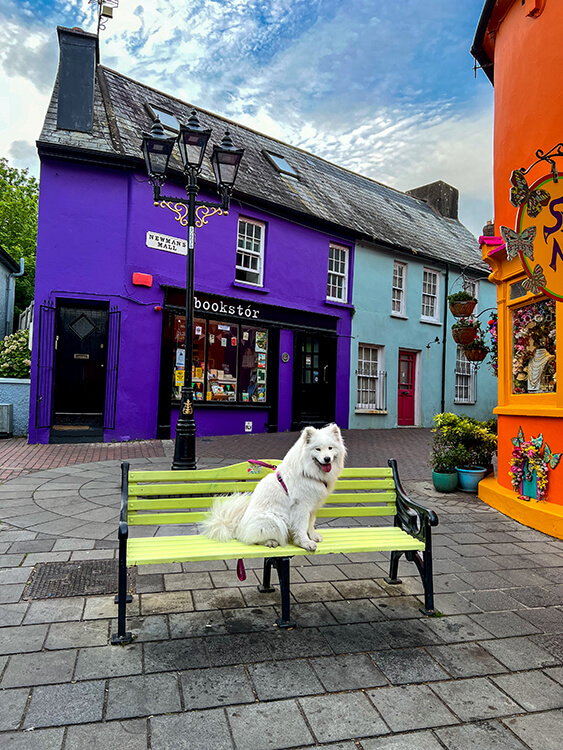
Kinsale: The Southern Gateway to the Wild Atlantic Way
Kinsale is the quintessential fishing town and the gateway to the Wild Atlantic Way. Famous for its colorful houses, as the gourmet capital of Ireland with excellent restaurants including Michelin-star Bastion and the scenic harbor with two forts, Kinsale was our perfect base for a few days exploring West Cork – including taking a day trip to Cobh. Here’s what not to miss in Kinsale:
- Spanish Galleon Mast in Kinsale Harbour is a replica mast from the Spanish ship. It commemorates the 400th anniversary of the Battle of Kinsale (1601).
- Kinsale Old Town is filled with brightly colored houses and buildings. Stroll around and pop by a few pubs for a drink.
- Have breakfast at the dog-friendly Cosy Cafe on the Church Square. Everything on the seasonal menu is sourced from local suppliers. Go for the full Irish breakfast! And don’t be surprised if dog-loving locals order some sausages for your pup.
- Take a sunet stroll along the quay of Kinsale Harbour before finishing the evening with some ball at the Kinsale Town Park.
- Try the local lobster at Fishy Fishy Restaurant , an award-winning seafood restaurant helmed by owner-chef Martin Shanahan, one of Ireland’s leading seafood chefs. The outdoor terrace is dog-friendly.
- Dine on the finest grass-fed, dry aged beef and lamb from the family farm at Finns Farmcut . The surf and turf with local scallops is an excellent choice to savor both the farm dry-aged beef and local seafood. Not that Finns Farmcut is not dog-friendly.
- Have a leather bag handcrafted at the Danny Albu Leather Studio of Kinsale . I had a beautiful leather tote bag made to carry all of Coco’s things. And Danny even made a matching pouch for Coco to attach to her harness.
- Don’t leave Kinsale without trying the to-die-for pastries at Seeds Bakery . The artisan bakers specialize in sourdough and are focused on sustainability, using as many local products as possible.

Cobh: Titanic’s last port of call in 1912
Then named Queenstown, Titanic made its final port of call on 11 April, 1912 in Cork Harbour before continuing on its ill-fated voyage. Today the beautiful town still holds a deep connection with Titanic, and a Titanic Trail along with the Cobh Heritage Center, located in the town’s former White Star Line Ticket Office, tells the story of the Titanic’s last stop in Ireland and the lives of the 123 passengers who boarded the ship there.
Here’s how to spend a day exploring Cobh with a dog:
- Take a photo of the Deck of Cards Houses from West View Park on Cobh’ steepest street.
- While the Cobh Heritage Center and Titanic Experience there aren’t dog-friendly, you can go on a dog-friendly Titanic Trail Tour walking tour of Cobh. Well behaved dogs on a leash are welcome on the tour.
- Relax in the seafront John F. Kennedy Park. There’s sculptures like The Navigato, a canyon, the Cobh Band Stand where there’s live music, and a farmer’s market on Friday mornings.
- Take a photo at the White Star Line Building. This was the former offices and where the last passengers boarded Titanic in Cobh. Today it houses the Titanic Experience Cobh , though the museum is not dog-friendly inside.
- Take a photo at the Cunard Line Offices Building, where most of the 764 people saved from the torpedoed Lusitania were landed on 7 May, 1915.
- Visit the Lusitania Wall of Remembrance, a memorial to the lost souls of the torpedoed Lusitania. The torpedoing of this passenger ship catapulted the US in to WWI.
- Visit the RMS Lusitania Memorial
- Get your dog a treat at Stockbull Pet Store right on main street in the center of Cobh. Then visit a dog-friendly pub like The Mauretania Bar for a pint.
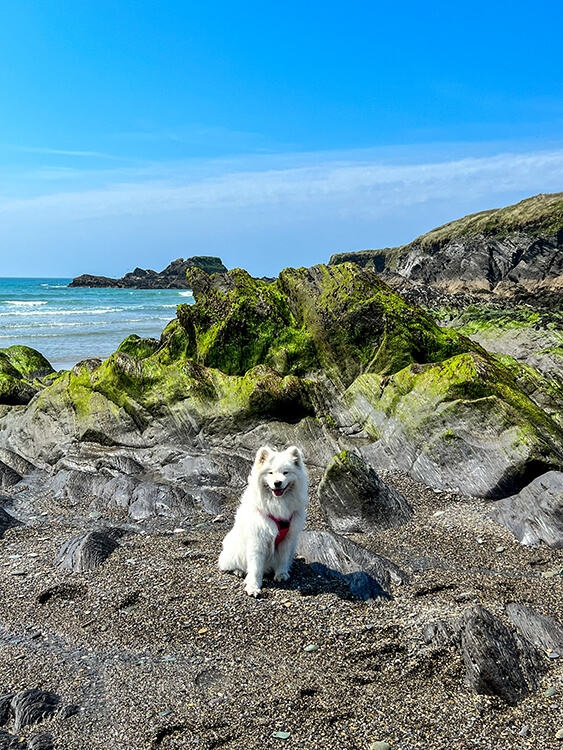
Long Strand Beach: Renowned Surfing Beach in West Cork
The 1.5 mile long beach is one of Ireland’s most beautiful beaches. Aptly named Long Strand Beach, it’s also a year round dog-friendly beach popular for beach walks and surfing. Just mind the strong currents and steep drop off from the shore.
At the end of Long Strand Beach is The Fish Basket , a small fish and chips shop serving up local fish and scampi sourced from West Cork. Instead of traditional fish and chips, we opted for their fish tacos. Hake is battered, fried crispy, and served in flour tortillas with their tomato salsa and lime dressing. Of course, the tacos come with a side of chips and mushy peas. It’s a delicious way to spend an afternoon on the Wild Atlantic Way.
The Fish Basket is dog-friendly outside. Grab one of their picnic tables or bring a beach blanket and enjoy on the beach!
Just a few minutes drive from Long Strand Beach, you can also stop for a brief walk at Galley Head. It’s a scenic spot for beautiful views of the Wild Atlantic Way coastline. The Galley Head Lighthouse , built in 1875, is also located there. It’s still a functioning lighthouse, and along with the Fastnet lighthouse, are two of the most powerful lighthouses in Europe. There’s actually no public access to walk out to the lighthouse, and it is not open to the public for visits except during Heritage Week in late August each year. But Galley Head Lighthouse is one of the Irish lighthouses you can stay in and offers two restored lightkeepers cottages. However, it is not a dog-friendly lighthouse stay.

Barley Cove: One of the Most Beautiful Beaches of County Cork
Definitely one of the most unique beaches we visited on the Wild Atlantic Way, Barley Cove Beach needs to be on your dog-friendly Ireland road trip itinerary. It is one of Ireland’s most beautiful beaches and well worth going a bit out of the way for.
Barley Cove isn’t a beach you just stumble upon. It’s tucked away off the winding roads of County Cork between Mizen Head and Brow Head. And then accessed by a short walk along a wooden boardwalk through sand dunes before crossing a tidal stream via a floating pontoon bridge to finally reach the cove.
The whole area was formed as a result of a tsunami following the Lisbon earthquake in 1755. According to signs along the wooden walkway, a newspaper in County Cork reported 15-foot all waves that washed sand ashore. It remains to this day and is jaw-droppingly beautiful. Barley Cove Beach itself has been designated as a Special Area of Conservation by the EU. The beach is wild and the sand pristine.
The rural Barley Cove Beach is rarely crowded and it’s a year round dog-friendly beach.
County Kerry

Skellig Islands: The Star of the Wild Atlantic Way
The Skellig Islands are known as the star of the Wild Atlantic Way. The uninhabited islands lay 12 kilometers (8 miles) off Ireland’s southwest coast and are only accessible by boat. Lashed mercilessly by the Atlantic, monks still chose the twin-peaked Skellig Michael to build a monastery as it was as far away from civilization in the 6th century and as close to God.
As playwright George Bernard Shaw said, Skellig Michael is ‘a part of our dream world’. Skellig is old Irish for sharp rock in the sea, and it is exactly that. A seemingly impossible world suddenly jutting sharply out of the sea. It’s no wonder such an otherworldly place was chosen as a filming location for Star Wars Episode VII – The Force Awakens.
The trip out to Skellig Michael and its sister island Little Skellig is not for the faint of heart. The trip can be made weather permitting between April and October. Only a handful of boats are licensed to land on Skellig Michael, and on the days you can land a guide is required to climb the 618 steps to the 6th century monastery where monks lived for over 600 years. The monastery and Skellig Michael is one of only two UNESCO World Heritage sites in Ireland.
Dogs are not allowed on Skellig Michael as it is a bird sanctuary to the 35,000 pairs of gannets that live there, but dogs can make the boat trip with Skellig Tours .
Tim was going to do the hike while I stayed on the boat with Coco and the resident dogs, but it turned out it was much too rough to land as planned. The incredible sight of the islands makes you immediately forget you’re a little green around the gills. It’s a full day trip out to the Skelligs, along with sailing around Bull Rock and under Ireland’s only cable car at Dursey Island, but definitely worth it to see a truly bucket list remote location.

Ross Castle: Ancestral Home of the Chiefs of the Clan O’Donoghue
The 15th century tower house, Ross Castle, sits on the on the edge of Lough Leane in Killarney National Park. It was built between 1450 – 1500 by Irish chieftain O’Donoghue Mór, who ruled the Killarney territory at the time.
O’Donoghue Mór lost the castle in a battle and there’s a legend that says he fell from one of the tower windows and disappeared in to Lough Leane with his horse. It’s believed he lives in the lake with his horse still watching over his castle. Every seven years in May he rises with his magnificent white horse, and if you catch a glimpse you’ll have good luck for the rest of your life.
The castle is restored with period oak furniture and you can take a guided tour of the interior. Dogs aren’t allowed on the castle tour, but you can explore the grounds of Ross Castle with your dog free of charge.
County Clare
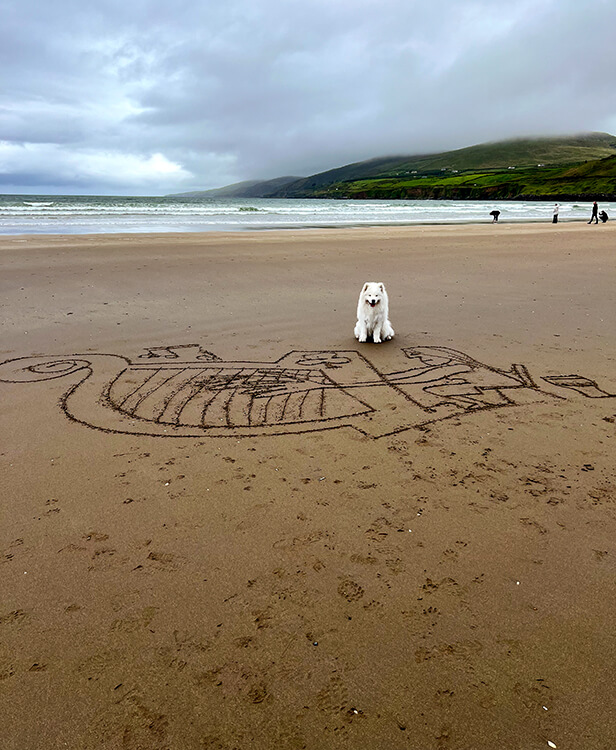
Inch Beach: One of Ireland’s Handful of Beaches You Can Drive a Car On
Inch Beach is famous for being the place where an inch is actually 3 miles long. Flanked by sand dunes with the Slieve Mish Mountains rising up behind, the mirror-like sand at low tide reflects the dramatic scenery.
It’s also one of just a handful of Ireland beaches that you can drive a car out on to and cruise down the 5.5 kilometer long sandy beach. Inch Beach is also a popular surf beach with surf schools located up and down the strand.
Inch Beach is dog-friendly with some restrictions. From June 1 – September 15, dogs are restricted from the blue flag area of Inch Beach between 11am – 7pm. Dogs on a lead are welcome year round outside the blue flag area and before 11am or after 7pm within the blue flag area during the high summer period.

Vandeleur Walled Garden: One of Ireland’s Most Spectacular Walled Gardens
County Clare’s Vandeleur Walled Garden is one of Ireland’s most spectacular walled gardens. And it’s worth the stop on the drive from Killarney National Park to the Cliffs of Moher.
Set of the grounds of the former ancestral home of the Vandeleur family, the gardens are stunning. There’s fun touches like a labyrinth and lawn games like a giant chess game, a Victorian style greenhouse, a cafe, kid’s play area, garden center to purchase plants, and – best of all – it’s dog-friendly.
You can purchase the Two County Clare ticket that includes the visit to Vandeleur Walled Garden + the Cliffs of Moher. Both attractions are dog-friendly and dogs are free of charge. Dogs should remain on a lead.

Cliffs of Moher: Ireland’s Most Dramatic Cliffs
There are few places in Ireland as dramatic as the jagged limestone cliffs soaring up to an impressive 700 meters. The Cliffs of Moher are considered by most as a highlight of any trip to the Emerald Isle, and are Ireland’s most visited natural attraction with over 1 million visiting annually.
No trip to Ireland is complete without visiting the Cliffs of Moher. In a true Instagram vs. reality moment, we arrived at the Cliffs of Moher in a foggy white out on our first attempt. Luckily we planned to stay a few nights near the Cliffs of Moher, and the next morning was overcast but clear.
Plan to spend at least half a day at the Cliffs of Moher. There’s a coastal cliff walk that runs for 20 kilometers, and you can walk as far or as short as you want. I recommend to walk at least a part of it, because the changing views of the Cliffs of Moher are truly a spectacular sight on the Wild Atlantic Way.
Dogs on a lead are welcome to enjoy the Cliffs of Moher, with the exception of inside the Cliffs of Moher Experience Center and the O’Brien Tower. There’s even a doggy pit stop station with water to stay hydrated.
If you’re visiting independently like us (not on a tour), aim for visiting early in the morning or in the evening. The peak hours when tour buses arrive are from 11am – 4pm. Outside the peak hours is the most enjoyable time to visit as the path is narrow and can get crowded.

The Burren: Home to the Oldest Archaeological Monuments in Ireland
Located just 30 minutes from the Cliffs of Moher, the Burren National Park is one of Ireland’s most unique landscapes. The name quite literally means “rocky place” and the vast Burren really does look otherworldly. May just happens to be one of the best times to visit when the wildflowers are in bloom, painting the rocky landscape with strokes of pinks, blues and purples.
The Burren is also home to one of the densest concentrations of archaeological remains in Ireland, including megalithic tombs and Bronze Age farmsteads and field walls. You’ll also find the oldest dated megalithic monument in Ireland in the Burren. Called Poulnabrone Dolmen, the megalithic portal tomb dates back to 5800 BC.
The Burren National Park is free to visit and is dog-friendly. Dogs just need to stay on a lead as the Burren is a fragile ecosystem and there is wildlife like hares, wild goats, voles and other animals.
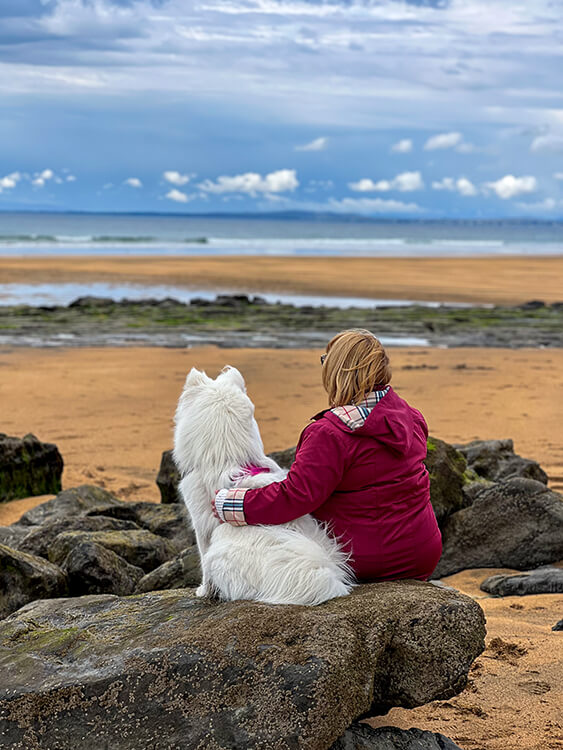
Fanore Beach: Sand Dunes on the Edge of the Burren
While crowds flock to the nearby Cliffs of Moher, few continue down the coast to gorgeous Fanore Beach at the edge of the Burren. It’s another of Ireland’s Blue Flag Beaches, meaning it is recognized for its swimming quality and is life guarded in season.
The golden arc of sand is part of the dune system and where the Caher River flows out in to the Atlantic. The picturesque beach is strewn with limestone boulder that were transported by melting glaciers and ice sheets that once covered Ireland and dropped over 15,000 years ago on the Burren and the beach.
Fanore Beach is also really easy to access. There’s a huge parking area just off the R477, and then at the end of the parking area is a short boardwalk and staircase descending down to the expansive beach.
Fanore Beach is dog-friendly with some restrictions. From May 15 – September 15, dogs are restricted from Fanore Beach between 11am – 6pm.
O’Donohues Pub is practically across the road from Fanore Beach and is known for their fish and chips, which we found to be very good. There’s just a handful of picnic tables outside, which are dog-friendly.
County Mayo
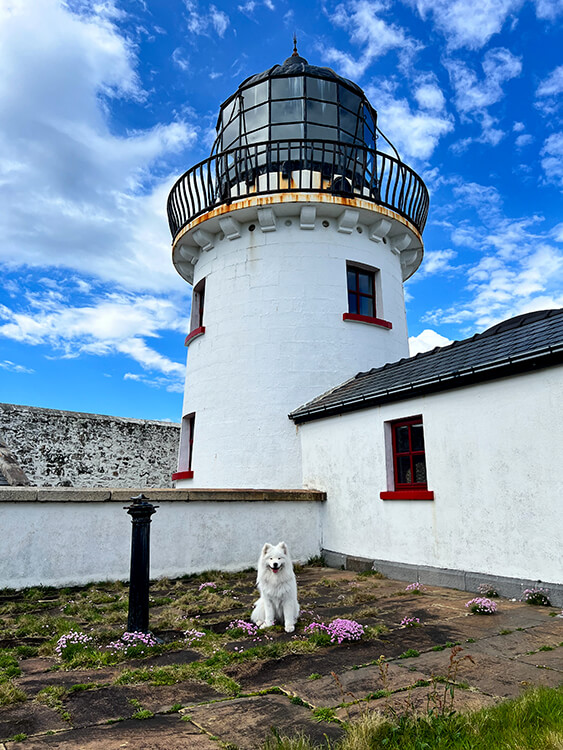
Clare Island: the Famous Home of Pirate Queen Grace O’Malley
Clare Island was, for us, the absolute highlight of our Wild Atlantic Way road trip. Located just 6 kilometers (3.5 miles) off the west coast of County May, Clare Island is famous as the 16th century pirate queen Gráinne O’Malley.
A distinctly treeless island, the sparsely beautiful land, towering cliffs and white sand beaches make it an alluring island to explore. There’s a population of just 160 people, and the island is mostly unspoiled. But it crowned with another of Ireland’s most beautiful and must-see lighthouses. It’s the privately owned Clare Island Lighthouse , which after being decommissioned after 159 years of continuous service was restored and turned in to a luxury B&B.
And the dog-friendly Clare Island Lighthouse is where we spent our most magical stay of our Ireland road trip. Entirely enclosed and walled in, Coco had the full run of the lighthouse and grounds to explore. Dogs can even climb the lighthouse tour, which just happens to be the absolute best place to watch the incredible sunset over Clew Bay.
Walking or biking is the primary activity on Clare Island, and there’s a lot to see. You can visit the blue flag Clare Island Beach or make the trek to the sheltered cove for a swim, see Granuaile’s Castle where Grace O’Malley lived, visit the Clare Island Abbey and see the megalithic tomb dating back 4000 years.

Westport House: One of Ireland’s Most Beautiful Historic Homes
Westport House is one of Ireland’s most beautiful historic homes and is considered one of Ireland’s national treasures. It was built by and lived in by the Browne family for over 300 years before the Hughes family, another local and historic family, bought Westport House in 2017. The 18th century Palladian mansion and 400-acre estate is open to the public, and it’s a beautiful place for a walk with your dog.
While dogs are not allowed inside Westport House itself for the guided tour, dogs are more than welcome on the estate grounds on a lead. It is free to visit and walk the estate grounds, and locals love to walk their dogs here. If you are at least two people, you can also take turns on the self-guided tour of the house.
There’s also a variety of food trucks open year round, giving you dog-friendly dining options on the Westport House estate grounds.
County Donegal

Narin-Portnoo Strand: A Gem in the Heart of Donegal
Stretching over 2 kilometers in length, Narin-Portnoo Strand is one of the most beautiful beaches of Donegal and a must-see on the Wild Atlantic Way. It’s a beach renowned for excellent surfing conditions.
You also want to be sure to drive up the road above the beach for panoramic views of Gweebarra Bay, the snaking beach and the surrounding mountains.
Narin-Portnoo Strand is dog-friendly with some restrictions. From June 1 – September 15, dogs are only allowed in dog-friendly zones between 11am – 7pm.
There is also a year round dog beach called Dooey Beach if you make about a 20 minute drive around the bay. It is accessed by a narrow country road and quite off-the-beaten-path.

Doe Castle: Historical Stronghold of Clan tSuibhne
Doe Castle sits on an inlet of Sheephaven Bay in County Donegal and is famous as the medieval stronghold of the Scots-Irish MacSweeneys (Clan tSuibhne). The fortress was built in the 1420s and for nearly 200 years served as home, refuge and bastion for at least 13 MacSweeney chiefs.
Of course, like many castles and places in Ireland, there’s a tale about Doe Castle. Verona may have had Romeo and Juliet, but Doe Castle had its own starcrossed lovers: Turlogh and Aileen. And the tale about their tragic love is written in song by Níall Mac Giolla Brigde. Aileen’s father imprisoned, tortured and killed the Gaelic Turlogh when he discovered his daughter’s love affair. She saw her father kill Turlogh from the top of the circular tower, and jumped to her death in agony. Local fisherman have been known to tell a tale of seeing a phantom boat being rowed by ghost lovers in Sheephaven Bay.
The grounds of Doe Castle are open year round and it is free to explore as long as the lock is unlocked. More likely than not, you’ll have Doe Castle completely to yourself to explore. Visitors are welcome to enter through the gate and take a self-guided tour using the information panels placed around the partially ruined castle.

Fanad Head Lighthouse: One of the Most Beautiful Lighthouses in the World
Standing between idyllic Lough Swilly and Mulroy Bay, Fanad Head Lighthouse is a Wild Atlantic Way highlight. It’s not only one of the most beautiful lighthouses of Ireland, but was also voted one of the most beautiful lighthouses in the world. First lit on Saint Patrick’s Day 1817, Fanad Head Lighthouse is still a working lighthouse today.
Though a working lighthouse, visitors can take a guided tour to learn about the history and climb to the top to see the functioning light and views of the surrounding area. Fanad Head Lighthouse is dog-friendly and well-behaved dogs can join the guided tour. However, there is a ladder you have to climb to reach the top of the tower, so dogs cannot make the climb to the top. If you are at least two adults, the guide will allow you to take turns climbing the tower while one person stays with your dog.
You can also stay at Fanad Head Lighthouse with a choice of three different restored light keepers homes. And the accommodation is dog-friendly.
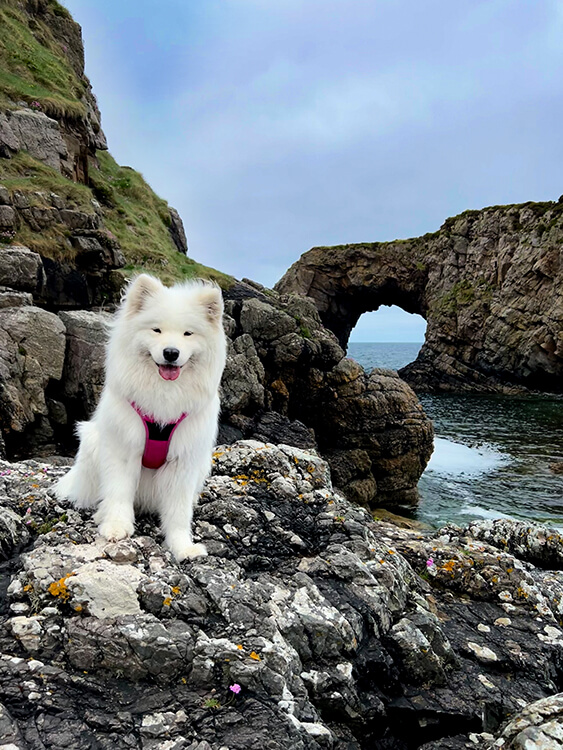
Great Pollet Sea Arch: Ireland’s Largest Sea Arch
Great Pollet Sea Arch is Ireland’s largest sea arch and a natural wonder that was created by the wind and waves of the Atlantic over thousands of years. Just a few minutes drive from Fanad Head Lighthouse, you don’t want to miss this window to the sea located on a totally unspoiled stretch of coastline.
There’s a large parking area, and then you walk down a quiet road for around 500 meters to the pathway to Great Pollet Sea Arch. The pathway leading down to the sea is a bit steep, but there are benches placed along the fenced in path to have a rest along the way. At the end of the pathway, you do need to climb over a stile to access the rocky beach and you may have to carry your dog over.
Loved this post? We love when you share our content! ~ Jen & Tim
About Jennifer Dombrowski
Jennifer Dombrowski is an independent travel publisher and an American expat who has lived in Bordeaux, France since 2016. She previously lived in Northern Italy in a small village near Venice for seven years where she fell in love with wine and wine tourism. She is an award-winning travel writer. She is also a travel correspondent on Traveling on the American Forces Radio Network. Luxe Adventure Traveler was named one of the top travel blogs to watch by the Huffington Post and TripAdvisor, and has been featured by top publications such as National Geographic, CNN, Buzzfeed, and Business Insider. Jennifer's photography has also been featured on publications such as USA Today and Travel + Leisure and on the Travel Channel.
Join our Adventure: Get all my insider tips for motorhoming & road trips

Visiting Ireland with a dog? Read this First!

Planning a trip to Ireland (either Northern, the Republic or both?) If you’re planning to visit Ireland with your dog, there are some important things you need to know.
Don’t forget to grab your FREE Ireland travel checklist below.
*We work hard to make this the best motorhome travel blog and road trip website possible, full of helpful content for you. The website is supported by our readers, so if you buy through links on this site we may earn a commission- at no extra cost to you. All opinions remain our own .
If you find this post useful, you can also treat us to a coffee – we promise to enjoy it while creating more useful content like this- we might even indulge in a biscuit (or two!)
JUMP AHEAD TO...
Is Ireland dog friendly?
One of the most common questions I get is ‘is Ireland dog-friendly’? I’ll admit, Ireland does have a reputation for being difficult for dog owners, for several reasons. Still, I spent two month touring Ireland with my dog Mac and we had a wonderful time.
In this post, I’ll share the tips and facts I learned about touring Ireland with a dog- and tricks to make it easier!
How to get to Ireland with a dog
There are a couple of ways you can visit Ireland with your dog. The first is to fly in, the second is to use a ferry. If you’re in Britain or France, most people tend to use the ferry, which is what I did. You can see more about my trip to Ireland and the ferry crossing here:
We hope you found the video useful. If you did, we’d love it if you followed us on Youtube . New videos with tips for motorhoming and campervanning in the UK and Europe are released weekly.
How to get to Ireland with a dog from UK (Britain)
Assuming you’re going road tripping or motorhoming/ campervanning in Ireland (and therefore taking your own vehicle), there are 3 main service providers for ferries to Ireland – Stena Line, P&O & Irish Ferries and there are several ferry routes to choose from:
- Holyhead to Dublin (Irish Ferries)
- Pembroke to Rosslare (Irish Ferries)
- Liverpool to Dublin (P&O Ferries)
- Cairnryan to Larne (P&O Ferries)
- Cairnryan to Belfast (Stena Line)
- Liverpool to Belfast (Stena Line)
- Holyhead to Dublin (Stena Line)
- Fishguard to Rosslare (Stena Line)
Note: not all of the above ferries run constantly or accept dogs.
There are 3 options for pets during a ferry crossing to Ireland: Pet Cabin, Onboard Kennels and remaining in your vehicle. Only a few of the routes have pet cabins or kennels, so you can expect your pet to stay in the vehicle on most crossings.
What’s it like onboard a ferry crossing to Ireland with your dog?
Well that will depends on who you sail with and what their setup is onboard. When I visited Ireland to explore the Wild Atlantic Way, I crossed from Fishguard to Rosslare and managed to get a pet friendly cabin, which was brilliant.
The cabin had a standard wipe clean floor, a couple of continental plugs, a mirror and four single bunks with all your bedding included. The bathroom is a good size. It’s not the most luxurious place in the world, but the crossing was under 4 hours and it was nice to be able to sleep and know Mac was happy and calm.

As I mentioned, each ferry will be setup different with what they offer for pets. Not all ferries have a ‘poop’ deck (like they do on Brittany Ferries pet cabin sailings to France ) so you might not be able to take your dog outside to relieve themselves until you get off the ferry.
Dogs aren’t allowed in the restaurant or anywhere else on the ship- you need to go directly from the vehicle to the pet cabin. If you have an anxious dog, you may not feel happy leaving them alone in the cabin if you want to get food or a drink- noisy dogs will be reported.
How much does it cost to go to Ireland with a dog
Obviously, this will vary depending on when you travel and how many of you there are (and how big your vehicle is).
As an example, in March 2023 I paid £250 for a one-way crossing from Fishgard to Rosslare for a 7m motorhome, one adult and one dog in a pet-friendly cabin.
Don’t forget, you can get discounts on most routes, through. If you book through a motorhome club , they can offer discounts to their members.

Paperwork your dog needs for visiting Ireland
To go from mainland Britain into either the Republic of Ireland or Northern Ireland, you need to have a couple of things for your dog/s:
- dogs must have had all normal ‘puppy’ vaccinations
- rabies vaccination (given at least 21 days before travel)
- your dog/s must have a registered microchip
- tapeworm treatment given by an approved vat 1-5 days before travel
TOP TIP: If you co-own your dog, make sure you have both of your details on the microchip. If an accident happens to one of you and the other has to take the dog home, they might not be able to travel with the dog if they’re not on the microchip.
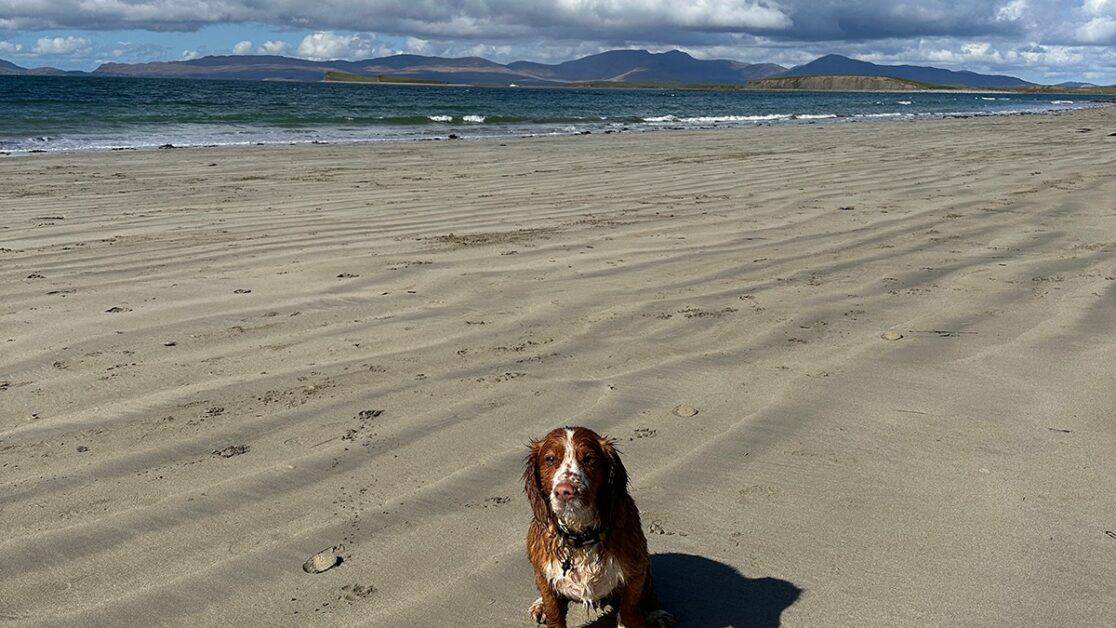
Pet Passport/ Animal Health Certificate
Lastly, you have to have an official travel document. This is either an EU pet passport or a UK animal health certificate.
1. If you have an in-date EU pet passport (not a UK one! ) and all jabs, vaccines and checks are up to date (meaning you’ve gone back to the issuing country in the last year with your pet), you can travel using this to Ireland.
2. If you don’t have an EU pet passport, you need to get an animal health certificate, issued by an approved vet. NOTE: Not every vet can issue one of these.
You can find out more about the animal health certificate and how to get one here .
I would recommend you get the tapeworm and the animal health certificate issued at the same time and make sure the vet signs, stamps and dates your document properly.
Travelling from Britain to Northern Ireland with a dog
There has been a lot of back-and-forth about the rules after BREXIT for visiting Northern Ireland with a dog. When I travelled, it was exactly the same as the rules for visiting the Republic of Ireland but for the most up-to-date information, please check the DAERA website .
However, I can confirm that (at time of writing) you don’t need another tapeworm to travel from the Republic of Ireland into Northern Ireland and vice versa. You also don’t need a tapeworm in order to come back to Britain.
Arriving in Ireland with a dog – what happens?
On the crossing to Ireland, no one checked Mac’s paperwork at all- which is bad! It would have been so easy to arrive in Ireland and realise I’d forgotten it. But there no checks at all at Fishguard.
When I arrived in Rosslare (Ireland), I drove around a corner in the port and found the pet admin area. There were two lovely women who checked Mac’s microchip and paperwork (including the tape worm time and date) and made sure that everything was in order.
And that was it. It was really straightforward.
Note: Bear in mind that if you amend your travel days after the tape worm has been given (as I had to), you’ll need to consider how that impacts the tape-worm travel window.

How dog friendly is Ireland?
Ok, so I’m finally in Ireland with my dog. What’s it really like? Is it true that Ireland is not dog-friendly?
Well, my friend, I’m pleased to share that Ireland is awesome if you have a dog.
I visited Ireland in March and April and I LOVED it. The weather wasn’t great, but we had some sunny days and there were so many beaches which Mac loved to run and play on- we often had huge stretches of them to ourselves. We spent time in the mountains and all around Ireland hiking and enjoying the beautiful scenery.
Now, it’s not all sunshine and roses. There were some weird things you should know about before you bring your dog to Ireland…
- Between beginning of June- mid September, many beaches are closed to dogs, particularly between 11-7pm
- Historic places often ban dogs (as they do here in Britain)
- Pubs, cafes and some restaurants were very dog friendly
- He was allowed at Powerscourt Waterfall (Wicklow Mountains) but not at most other private waterfalls, even when they’re in a park or something.
- THERE ARE NO PUBLIC BINS (see below)
The worst thing about travelling with a dog in Ireland
The worst thing about travelling with a dog in Ireland is that there are no bins in public places. Or very VERY few. The Irish motto is to ‘take it home’ which is wonderful and admirable but useless if you’re touring on a road trip and don’t have anywhere to dispose of your dog’s deposits like a responsible owner.
I found this the most challenging part about vanlife with a dog in Ireland, but I got around it.
- Get a Dicky Bag. This is GENIUS for giving you somewhere hygenic to store your filled baggies until you can find a public bin (and it stops all smells)
- If you have a garage or backbox, use that to store filled baggies until you find a bin
- Visit fuel stations (which almost always have a public bin). I ended up only filling my fuel tank half full so that I had an excuse to stop more often and get rid of rubbish and dog deposits.

5 of my favourite places to visit with a dog in Ireland
Here are some of my favourite places I visited with Mac in Ireland
- Wicklow Mountains
- Portnoo Beach
- Powerscourt Waterfall
- Achill sound (specifically Keel Beach)
- Ladies View and Killarney National Park (Ring of Kerry)
but there are so many more it’s impossible to list them all!
READ MORE: 7 epic Ireland road trip itinerary ideas
Heading back to Britain from Ireland with a dog
The process of bringing your dog back to Britain after visiting Ireland is fairly straightforward, as long as you don’t do a detour into France.
If you’re going directly from Ireland or Northern Ireland back into Britain, you don’t need a tape worm or even need to visit a vet. You just need to have their paperwork on hand when you cross the border.
Would I go to Ireland with my dog again?
In a word? Heck yes! It was fantastic. I definitely wouldn’t go between June- September and I’d be better organised in terms of rubbish and doggie deposits, but I can’t wait to go back and explore again someday soon!
Related Posts:
You might find these posts helpful for planning your Ireland road trip:
- 7 awesome Ireland itinerary ideas
- Motorhoming and campervanning in Ireland – everything you need to know
- Touring with a dog- 10 things they NEED

Kat never planned to buy a motorhome. She also never planned to quit her job as an air traffic controller, go touring around Europe in said motorhome, start one of the UK’s largest motorhome travel websites… or get a cocker spaniel.
Find out how she went from stuck in the rat race to being a digital nomad and inspiring thousands of people to have their own epic adventures here.
If you’d like to connect with Kat, send her an email or follow her adventures on social media.
Last update on 2024-09-25 / Affiliate links / Images from Amazon Product Advertising API
Sharing is caring!
Similar Posts
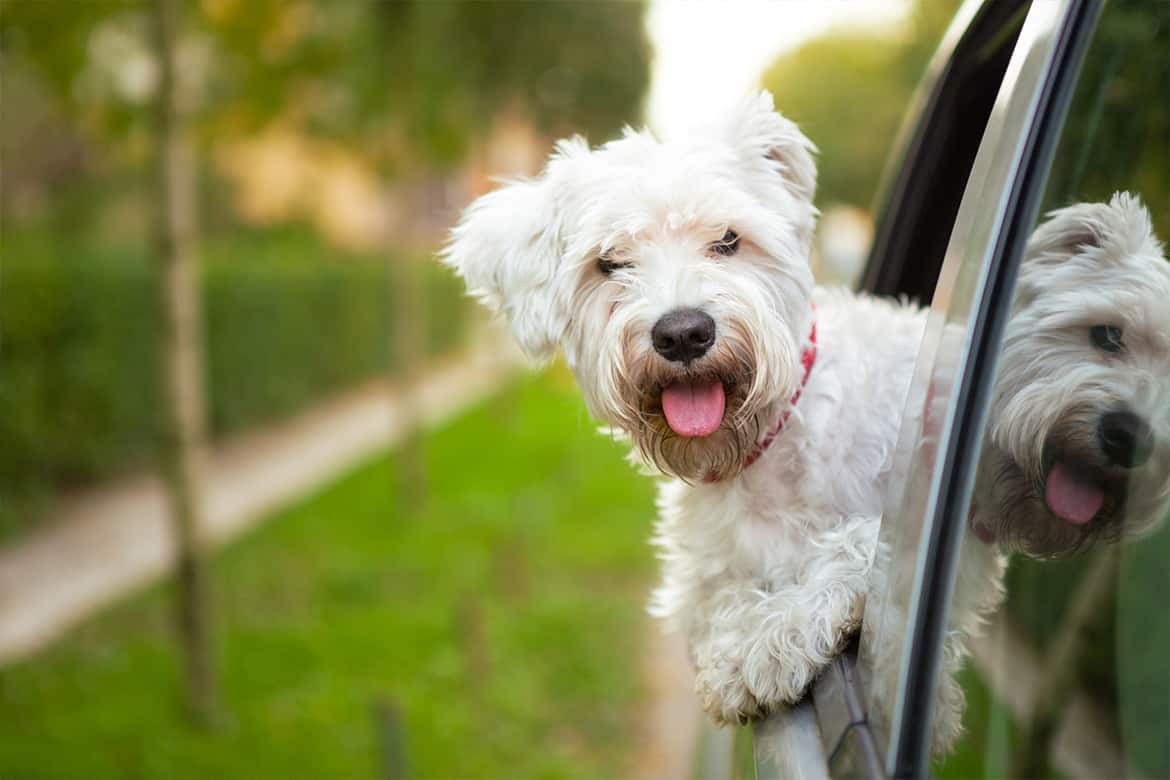
Travelling with a dog this Summer? READ THIS FIRST!


Introducing our Adventure Puppy!
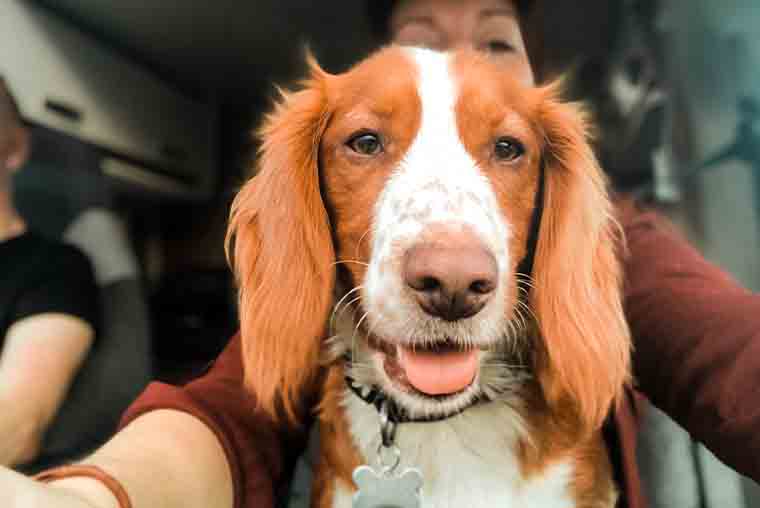
10 essential Dog Motorhome & Caravan travel accessories

Taking a Dog to France or Europe- Complete Guide

Ireland road trip – 7 epic Itinerary ideas to inspire you

Motorhoming and Campervanning in Ireland- The Ultimate Guide
Leave a reply cancel reply.
Your email address will not be published. Required fields are marked *
Save my name, email, and website in this browser for the next time I comment.

Dog-Friendly Republic of Ireland: Travelling with a Dog
When I travelled to the Republic of Ireland with my dog in 2017, I found it to be one of the less dog-friendly countries in Europe . This was followed up by my survey on the percentage of dog-friendly hotels in different cities across Europe, that ranked Dublin in last place.
However, Ireland is an amazing country with very welcoming people. And with the changes to rules regarding dogs in restaurants and cafes since my visit, you definitely should consider visiting this country with your pup.

Travelling to Ireland with a Dog
Ireland is one of the countries in Europe that requires your dog to have a worming treatment done before arrival. This echinococcosis worming treatment needs to be done by a vet between 24 hours and 5 days of crossing the border, and is then recorded in your dog’s pet passport.
Note that this doesn’t apply to dogs travelling into Ireland from Northern Ireland, as well as Finland, Malta and Norway.
Otherwise, the standard rules apply for dogs travelling to Ireland as for other EU countries, whether travelling from another EU country or from outside of Europe .
Following the end of the Brexit transition, pets travelling to Ireland from Great Britain now require a microchip, rabies vaccine, worming treatment and pet health certificate or EU pet passport (not including UK-issued pet passports from prior to 1 January 2021).
However, there is no change to the rules for pets travelling across the border from Northern Ireland, which is still classified as part of the EU for pet travel purposes. Technically a microchip, rabies vaccines and pet passport is required, but pet passports are unlikely to checked when driving across the border.
If flying to Ireland from outside of the EU and a handful of other European countries, you will also need to notify the authorities in advance of your dog’s arrival, with compliance checks performed on arrival, with a fee applying.
For more details on the logistics of travelling to Ireland, whether by road, ferry or flying (including how to notify the authorities), check out my complete guide on travelling to the Republic of Ireland with a dog , plus my specific guide on flying to and from Ireland with a dog .
Dining Out in Ireland with a Dog
Unfortunately, when I visited the Republic of Ireland in July 2017, there was still a law in place preventing dogs from dining inside cafes and restaurants. It was doubly unfortunate, as it rains a lot in Ireland (meaning outdoor dining isn’t often an option), plus there were a lot of buskers (and my dog is alarmed by the clapping that naturally follows).

However, in December 2017 there was a law change, and these days it’s up to the owners of cafes and restaurants whether they allow dogs inside. And the situation is only likely to improve, when compared to the number of dog-friendly cafes and pubs in the United Kingdom .
While I can’t make any recommendations, there’s plenty of tips for around the country in this guide . Also check out this page for some of the best dog-friendly indoor dining restaurants.

Taking a Dog on Public Transport in Ireland
While in Ireland, we drove around in a hire car , so weren’t subject to the rules for public transport. If you’re visiting Ireland, I recommend doing the same, at least if you have a larger dog. Generally public transport in Ireland isn’t that dog friendly, with only small dogs sometimes being allowed on board.

The most generous rules are with Irish Rail , which operates a mixture of inter-city services, commuter services and the DART (Dublin Area Rapid Transit) coastal train. Small dogs can travel free of charge if they travel on your lap, either in a container or simply on a leash. However, if someone objects, you’ll need to move to another part of the train.
For larger dogs, other than guide dogs and assistance dogs, they can only travel in the guards vans where available, basically on the inter-city Dublin to Cork and Dublin to Belfast services. They must be muzzled , labelled and a fee is charged.
Bus Éireann is the long-distance bus service operator in Ireland, plus operates local services in cities outside of Dublin. Despite the dog in its logo, but not surprisingly given that most long distances buses on continental Europe don’t allow dogs, pets dogs are also forbidden on these buses .
If you’re in Dublin, you might have better luck. The buses in Dublin are operated by by Dublin Bus . I’ve heard reports that dogs are permitted at the discretion of the driver, with permission most likely to be granted to small dogs in a carrier bag. However, there’s no clear policy anywhere on their website at the moment.
Luas, the light-rail operator in Dublin, is a little clearer but more excluding in its rules . Only dogs in an appropriate enclosed pet carrier are allowed, although it’s still at the discretion of staff.
There is a petition to make public transport more pet-friendly in Ireland – consider signing it!
Dog-Friendly Accommodation in Ireland
Ireland’s not the easiest place to find dog-friendly accommodation. In my recent research , Dublin came in last along with Lisbon for having the lowest percentage of hotels and inns that allow dogs, a pitiful 4%. However, it’s still possible to find dog-friendly accommodation, you just don’t have as many options as many other countries.
In particular, I would recommend seeking out countryside B&Bs, or turning to Airbnbs. And make sure you book accommodation in advance, rather than relying on finding something at the last minute.

Dog-Friendly Sightseeing in Ireland
When travelling in Ireland with your dog, I highly recommend including these dog-friendly activities in your itinerary. They’re also some of the most scenic attractions for humans, too!
1. Visit the Cliffs of Moher
Don’t miss visiting the Cliffs of Moher while in Ireland. Located about 90 minutes south of Galway, these magnificent sea cliffs stretch for 14km and offer up superb views, both across the sea and of the rest of the cliffs.

At the main viewing points , there’s an entry fee charged, covering both entry to the visitors centre and parking. Depending on the time of day, it varies between €7 and €10 per adult.
Dogs are permitted in the main viewing point area, as long as they remain on a leash (a must in any case with the steep drops), although of course they aren’t allowed inside the visitors centre.
We actually visited later in the evening, without paying a fee (because the visitors centre had closed). We were staying nearby and wanted to catch the sun set, which occurs quite late in the summertime.

Unfortunately, dogs are no longer allowed along the Cliffs Coastal Walk, which crosses private farmland with livestock.
2. Take a Boat Trip to the Aran Islands
One of the most quintessential places in Ireland are the Aran Islands, located not far from the Cliffs of Moher. I would have loved to stay overnight on the islands, one of main places where Gaelic is still commonly spoken. (In summer many Irish teenagers attend summer camp on the islands to practice their Gaelic.)

Instead we took a day trip out to the islands, with dogs allowed on the multiple ferries that service the islands.
The main year-round ferries run from Rossaveel to the west of Galway, but during summer there’s also multiple ferries that run from Doolin, to the south of Galway. It’s possible to stay overnight out on the islands, or else do a day trip. We elected to do the latter to Inisherr, combined with a cruise past the towering Cliffs.
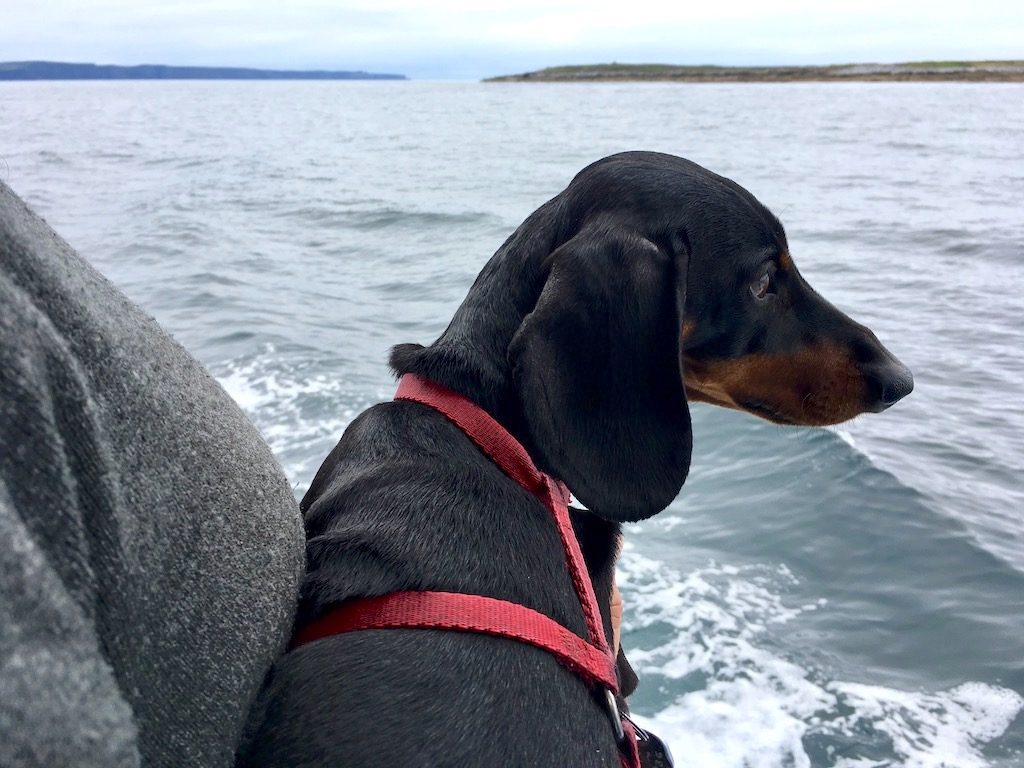
On Inisherr, our Schnitzel got plenty of friendly attention. Many visitors hire bicycles to easily get around the 2km by 3km island, but being accompanied by a dog, we just elected to walk to the scenic spots closer to town.
All of the pubs and cafes had outdoor seating, which worked well with the fine weather during our visit, although if it was raining it might be a bit tricky.

As there’s multiple companies that cruise to the Aran Islands, check in advance that the company that you’re booking with has dog-friendly boats. Additionally, if you’re wanting to stay overnight, there’s limited dog-friendly options, so book that first.
3. Explore the Connemara
Another great day trip from the Galway region is out to the Connemara. A district in western Ireland, it includes the 7000 acres of the Connemara National Park , a vast wild expanse of mountains and bogs, heathlands and lakes.

I recommend hiking 1.5km-long Sruffaunboy Nature Trail, which starts from the visitors centre. The hiking trail is a mixture of gravel paths and raised boardwalks (across the boggy sections), and I can attest it is do-able while carrying an umbrella.
Entry is free to the national park and dogs are allowed, except in the visitors centre, as long as they are kept on leash. The historic town of Clifden is also a great spot to stop for lunch.

4. Stand at the Edge of Slieve League
The Cliffs of Moher don’t hold a monopoly on sea cliffs in Ireland. Further north in Country Donegal is the mountain of Slieve League and its cliffs falling away to the sea.

Some visitors claim that this is more impressive than the more visited Cliffs of Moher, with the cliffs up to three times as high. Just keep an eye on the weather or plan to stay awhile, as when the frequent fog rolls in there’s not much to see!
While there is no entry fee, in the last couple of years, visitor restrictions have been introduced. During the peak months of July and August, you will no longer be able to drive to the closest carpark. Instead, you will need to park at the Ranger Station, with a parking fee of €5 for two-hours or €15 all-day, with a 1.5km walk to the cliffs.
Alternatively, you can park for free at the new Visitors Centre, which is located further away. There are regular shuttle buses running to the cliffs, with a charge of €6 per adult, but no indication of whether dogs are allowed, so I recommend trying to park at the Rangers Station carpark.

5. Spend a Day Driving the Ring of Kerry
Ireland is full of scenic drives, but my favourite from our road trip around Ireland was driving the 125 mile long Ring of Kerry. Stay in Killarney either side of your drive and spend a day driving the loop, or else stay along the way to explore more in-depth.

My favourite stopping points included taking in the view from Molls Gap, stopping in the cute town of Kenmare, clambering over the ruined Ballycarberry Castle in Castlequin, and exploring the Gap of Dunloe.

There’s even some great beaches to enjoy a walk on with your pup, although keep your dog leashed unless there’s clear signs that dogs are allowed off leash.
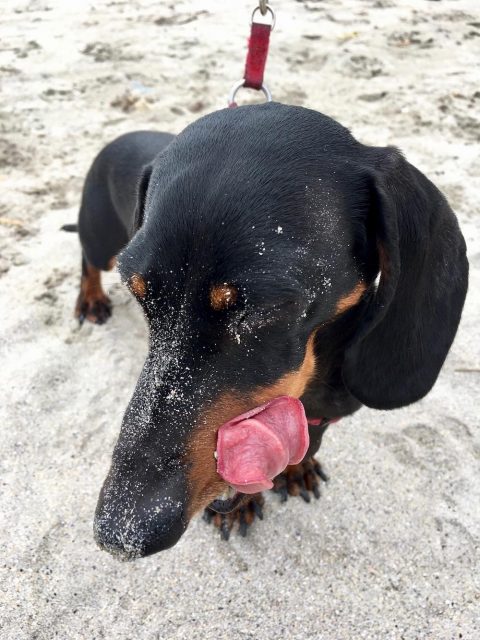
You May Also Like
- Travelling to the Republic of Ireland with a Dog
- The Most Dog-Friendly Ferry to All of Ireland
About the Author

Shandos Cleaver is the founder of Travelnuity: Dog-Friendly Travel. She has travelled extensively with her Miniature Dachshund, Schnitzel, including to 33 countries across Europe, every state and territory of Australia except Tasmania, and 10 of the United States. She’s passionate about providing inspiration and information to others wanting to travel with their dogs, whether close to home or internationally.
Inspired? Pin this to your Pinterest board!

12 thoughts on “Dog-Friendly Republic of Ireland: Travelling with a Dog”
Awesome post! When we were in Ireland in April, we saw a good number of dogs and it looked like they were all really enjoying being outdoors with their humans. I did worry about the dining, transportation and accomodation – so it’s good to know the rules are less strict. Of course, the big problem is actually getting your dog to Ireland since those transport rules are quite strict.
https://teaspoonofadventure.com/
Agreed that it can be tricky getting a dog there! I’m currently looking into the rules and will be writing about them. I had thought dogs aren’t allowed in the cabin in Ireland, but there’s actually no such rule. Plus, it’s easy to get there from the UK (for now!)
Super helpful!! Visiting Ireland in September with my pup. Thank you!
Great to hear Aly!
If you are coming to Ireland you should follow #packthepouch on Facebook or instgram for loads of information on places to eat, stay etc with your dog in Ireland- I’m Irish and I do
Thanks Jennifer for the tip! I just had a look and I think it’s “Pack the Pooch”.
Hey, loving your articles as usual! Just a note: on number 5 for the Ring of Kerry, I think you meant “Stay in *Killarney* either side of your drive”. All the Irish and Scottish names are throwing me off my planning X_X. At least in Switzerland, all the places have unique names. I feel like most things in Ireland and Scotland have similar names. And I used to live in Ireland!
Thank you so much for picking that up, I don’t know how no-one picked that up earlier. Interestingly, I live in Australia, so I’m used to half of our place names being the same as places in England or elsewhere.
I’m not really sure that Ireland and Scotland have similar places names. Do you have any examples?
FYI, currently you are not allowed bring a dog (whether it’s on a leash or not) onto lands at the Cliffs of Moher as it is private farmland. This is advised in the FAQs on https://www.cliffsofmoher.ie/faqs/
Thanks, I’ve updated the post to cover this, I think it used to be allowed when we last visited.
This seems to have been changed again:
We are totally dog friendly and love to welcome your furry friends. Please ensure dogs remain on leads throughout your visit. In common with other buildings in Ireland open to the public dogs are not permitted inside the visitor centre building unless they are registered guide or support dogs.
Leave a Comment Cancel reply
Save my name, email, and website in this browser for the next time I comment.
Pet Travel to Ireland [Pet Passport Ireland 2023]

Whether you are planning on visiting Ireland for a holiday, or are relocating there, you don’t have to leave your pets behind!
Taking pets to Ireland is pretty straightforward. Firstly, you need to ensure you have to correct documentation for an Ireland Pet Passport, or EU Pet Passport . Dogs, cats and ferrets are eligible for an EU Pet Passport which allows them to travel freely within the EU. Other pet species such as birds, rabbits and rodents are also able to travel from to Ireland simply, with other documents we will discuss below. Secondly, you will need to organise travel. You can either enter Ireland in a car, ferry or by air.
In this article, we will discuss in detail the process of taking a pet to Ireland. Additionally, we will walk you through how to obtain an Ireland pet passport and all the documents required.
TABLE OF CONTENTS:
- What is a Ireland Pet Passport?
What pet species can get an Ireland Pet Passport?
- Visit the vet
- Organise travel
- Microchipping
- Rabies vaccination
- Tapeworm treatment
- Rabies titer test / rabies blood test
- Health certificate
- CITES permit
- How much does an Ireland Pet Passport Cost?
Commercial transport of pets to Ireland
- Can I take my puppy or kitten?
- What if I lose my Irish Pet Passport?
- Can I travel to Ireland without an Ireland Pet Passport or EU Pet Passport?
- Can I fly with my pet in the cabin of the plane?
Bottom Line
What is an Ireland Pet Passport?
An Ireland is a compilation of documents that your pet needs in order to travel to Ireland. With an EU Pet Passport , dogs, cats and ferrets are able to travel throughout the EU without enduring a quarantine period. Pets will require a microchip and rabies vaccination at minimum, proof of both is needed in order to obtain an EU Pet Passport . All documents must be issued by an official veterinarian within the EU. Essentially, a pet passport demonstrates that your pet is fit and healthy to travel.
The documents required to travel with pets depends on which country you are travelling from, and which country you are travelling to. Each country has different rules and requirements to export and import pets. Requirements and restrictions also vary between pet species. We will discuss the requirements to travel to Ireland in detail below.
What does an Ireland Pet Passport contain?
An Ireland Pet Passport / EU Pet Passport contains all the documents required to travel with your pet. It will basically prove that your pet is fit and healthy to travel.
An Ireland Pet Passport contains the following information:
- Details of ownership (name, address, passport number, telephone, etc.)
- Description of the animal (name, species, breed, date of birth, etc.)
- Official veterinarian’s details
- Microchip information
- Rabies vaccination certificate
- Rabies antibody titer test results
- Parasite treatment records
- Additional vaccination and treatment records
- Pet photo (optional)
At minimum, your Ireland pet passport will contain those listed 1-5. These are compulsory in order to travel within the EU. Those listed 6-9 are potential requirements that your pet may need if you are traveling from outside the EU or from certain countries.
All records are signed and stamped by your official EU veterinarian with official stickers from the medication used.
Currently, under the Pet Travel Scheme , only dogs cats and ferrets are able to obtain an Ireland Pet Passport or EU Pet Passports .
However, this doesn’t mean that you aren’t able to take other pets to Ireland with you. If you wish to travel with a bird, rabbit or rodent, you will simply need alternative documents in order to travel. We will discuss this in detail below.
RABBITS & RODENTS
Rabbits do not require rabies vaccinations or a health certificate if traveling from other EU states as well as Andorra, Switzerland, Croatia, Iceland, Liechtenstein, Monaco, Norway and San Marino .
However, pet rabbits and rodents important to Ireland from any other non-EU rabies controlled country will require a health certificate. Furthermore, they will need to stay in quarantine for 4 months.
Birds are permitted to enter Ireland from other EU Member States or Andorra, Croatia, the Faeroe Islands, Greenland, Iceland, Liechtenstein, Monaco, Norway, San Marino, Switzerland and the Vatican City State .
However you will either need to travel with your bird, or provide an Owner’s Declaration. Furthermore, you will need to send an import form to the Department of Agriculture.
Birds entering Ireland with their owner or owner’s representative from other countries will need to meet the following requirements:
- Application for a Licence to Import Pet Birds, health certificate and Owner’s Declaration must accompany your bird;
- Your bird must reside in an OIE member country ;
- You are not importing more than 5 birds;
- Your bird must have undergone isolation for 30 days prior to export; OR
- Two vaccinations against avian influenza with the H5 vaccine between 60 days and 6 months of import; OR
- 10 days of isolation and undergone a test to detect the H5N1antigen or genome; OR
- 30 days of quarantine in a registered premesis in the United Kingdom or other EU countries;
- All permits must accompany birds that are covered by CITES; and
- Export permits may be required by the wildlife authority in the exporting country.
Birds must be imported at either Dublin or Shannon Airport.
For more information on the Pet Travel Scheme, check out What is The Pet Travel Scheme (PETS)? .
What is the process of obtaining a Pet Passport for Ireland?

VISIT THE VET
You will need to visit the vet to obtain your pet’s passport.
Before booking your appointment, check that your chosen vet is authorised to issue EU Pet Passports . Not all of them are.
At your appointment, your vet will administer your dog, cat or ferret with a microchip and rabies vaccination, if your pet hasn’t already had them. They will also perform a basic health examination to ensure your pet is healthy enough to travel. Once the veterinarian is satisfied that your pet is ready for travel, they will review all the paperwork and complete the pet passport booklet.
If you are traveling with a bird, rodent or rabbit, you should obtain a health certificate. This is only a requirement to enter Ireland from non-EU countries, however many airlines will require a health certificate to transport pets. It’s also a good idea to have the health of your pet checked for yours and your pets own wellbeing.
You will need to bring the following with you to the vet appointment:
- Your passport
- Your local address
- Microchip information (if your pet already has one) – date of implantation, chip number and issuing company information (this info is also on the Annex IV)
- Pet’s rabies certificate or rabies titre test results no less than 21 days old (if your pet has one)
- Annex IV form completed by your home vet and endorsed by your country’s official veterinary regulatory body (if you are from outside the EU)
- Pet photo (optional but recommended) – the size should be 2 x 2 inches (5cm x 5cm). It is better to have one as you do not want to give any customs official a reason to deny your pet entry into a country.
If your pet hasn’t yet been microchipped or vaccinated against rabies, don’t worry, your vet will complete these at the appointment.

ORGANISE TRAVEL
You will then need to figure out how you are traveling to Ireland. The easiest option is to travel by car, however you can also travel by air. Traveling by air is far more complicated as airlines have very specific rules and regulations when it comes to traveling with pets. Some airlines may even prohibit certain pet species, and breeds from boarding their planes.
When importing pets to Ireland, you must:
1. Enter Ireland through Cork, Dublin or Shannon Airport, or Cork or Rosslare Port.
There are compliance checks that may need to be completed when pets enter Ireland. These can only be done at these specific ports of entry.
You can enter Ireland from any port if traveling to Ireland with a dog, cat or ferret from EU states, as well as Andorra, Switzerland, Croatia, Iceland, Liechtenstein, Monaco, Norway and San Marino, you can enter at any port.
If you are traveling from any other country, you must enter through Cork, Dublin or Shannon Airport, or Cork or Rosslare Port.
2. Inform the Department of Agriculture in Ireland, if required.
All dogs, cats and ferrets traveling from outside the EU, or those traveling with other pet species from anywhere, must provide advanced notice to:
- Dublin airport [email protected]
- Shannon airport [email protected]
- Cork airport [email protected]
- Ringaskiddy port, Cork [email protected]
- Rosslare ferry port [email protected]
3. Organise compliance checks for your pet in advance of your arrival to Ireland.
All dogs and cats will undergo a health check upon arrival in Ireland. They must be found free of any evidence of disease communicable to humans. If your dog or cat is not in apparent good health, further examination by a licensed veterinarian may be required at your expense.
You can email your port of entry (see contact email addresses above) and must include the following information:
- Date and time of arrival;
- Flight Number;
- Number of animals to be checked; and
- Paperwork the pet will be travelling with e.g. EU Pet Passport or EU (Annex III) Health Certificate.
If you do not follow these rules, or your pet fails the compliance checks, you risk being refused entry. Alternatively, your pet may be placed into quarantine for the necessary tests or vaccinations. In very limited circumstances, your pet may be euthanised.
Travelling to Ireland in a car or ferry
You can take your pets to Ireland on a ferry, with or without a car. However, some ferry companies do not allow foot passengers to bring pets on board. Therefore you may only be able to transport pets to Ireland in a car.
Some companies will charge extra to bring your pet on board, while others don’t.
Whichever option you choose, be sure to let the company know that you will be bringing your pet with you. It is best to do this well in advance to ensure for a smooth journey.
Many ferry companies require pets to stay inside vehicles, which is why foot passengers are not permitted to bring pets.
Travelling to Ireland by air
Traveling to Ireland with pets by air is far more complicated than traveling by car or ferry. This is because airlines have strict rules, regulations and restrictions when it comes to traveling with pets. Many airlines will not allow pets to travel on their planes at all, however there are some that will.
Traveling via air is far more expensive too, as you will need to pay extra to ship your pet. The price will vary between airlines, and depending on the weight and size of your pet.
1. Before booking your flight, be sure to check out different airline’s policies to ensure that you are able to take your pet with you.
Some airlines may allow your pet to travel in the cabin with you, where others will require pets to travel in the cargo area of the plane. If you have a small dog or cat, then you may be able to take them in the cabin with you. However, if you have a large dog then he will need to fly in the cargo.
- 13 Airlines That Allow Flying With Dogs In-Cabin [Prices & Policies]
- 13 Airlines That Allow Flying With a Cat In-Cabin [Prices & Policies]
- Which Airlines Allow Ferrets In Cabin? [Policies & Prices]
- 13 Airlines That Allow Pet Birds on Planes [Policies & Prices]
- 7 Airlines that Allow Rabbits in the Plane Cabin [Policies & Prices]
2. All pets must enter Ireland through Cork, Dublin or Shannon Airport.
All pets must enter through these airports, and must undergo a compliance check. They will check all of your documents and do a health check on your pet. You must organise this with your port of entry.
3. When booking your flight, inform the airline that you will be bringing your pet with you.
Do this as soon as you book your flight, as airlines often have limitations on how many pets they can ship at any given time.
4. Be sure to get an appropriate travel carrier and get your pet used to spending time in it.
Different airlines have different size and weight restrictions when it comes to pet travel carriers. Be sure to check those of your chosen airline. If traveling in the cabin of the plane, the carrier must be small enough to fit underneath the seat in front of you.
To ensure that the journey is as stress-free as possible for your pet, ensure they are comfortable in their travel carrier.
What are the requirements for an Ireland Pet Passport ?

In order to get an Ireland Pet Passport, your dog, cat or ferret requires the following:
REQUIREMENT 1: MICROCHIPPING
All dogs, cats and ferrets must have a microchip in order to obtain an Ireland Pet Passport. No other pet species require a microchip.
A microchip is a electronic chip that holds a unique number traceable with a chip reader. It is place just under your pet’s skin in between its shoulder blades.
We recommend that this is the first step in the process of obtaining an Ireland Pet Passport. This is because if your pet isn’t microchipped before they get their rabies vaccination, then the vaccination may not be valid. This would therefore mean your pet would have to get vaccinated again.
REQUIREMENT 2: RABIES VACCINATION
All dogs, cats and ferrets must be up to date on their rabies vaccinations. No other pet species require rabies vaccinations.
In order to get an Ireland Pet Passport, you must be able to prove that your pet has had their rabies vaccination within the past year, but at least 21 days before your arrival in Ireland.
Ireland accepts the 3 year rabies vaccination for dogs, cats and ferrets. However, it should only be applied as a booster (not the initial vaccination).
Once your pet has entered Ireland, a 21 day waiting period is not required for subsequent visits, as long as their rabies boosters are kept up to date, and the other entry requirements are met.
If your pet is entering Ireland from a high-risk rabies country , it must wait for a minimum of 30 days after the primary or booster vaccination before receiving a rabies titer test. Please see below.
Rabies-controlled (listed Third) countries as classified by the European Union:
High-rabies (non-listed Third) countries as classified by the European Union:

It may be possible that you require the following:
- Health certificate (ANNEX III Form)
REQUIREMENT 3: TAPEWORM TREATMENT
Dogs will need a tapeworm treatment if traveling from any country other than UK, Finland, Malta or Norway. This only applies for dogs.
All dogs must be wormed by a vet, with this recorded in their pet passport.
The treatment must contain praziquantel and must be administered by a veterinarian. This needs to be done between 5 days (120 hours) and 24 hours before returning to the UK, based on your arrival time in Ireland. If you fail to have your dog treated within this time scale, then he or she may be put into quarantine for up to 4 months.
REQUIREMENT 4: RABIES TITER TEST
All dogs, cats and ferrets traveling from a high-risk rabies country , must pass a rabies titer test (rabies blood test).
A rabies titer test is a blood test to see whether your pet’s rabies vaccination was successful. Your veterinarian will need to take a blood sample at least 30 days after the rabies vaccination. The sample will then be sent to an EU -approved blood testing laboratory . The blood rest results must show that the vaccination was successful – i.e. your pet’s blood must contain at least 0.5 IU/ml of the rabies antibody.
You must wait 3 months before your pet can enter Ireland. If you do not wait 3 months, then your pet will be quarantined in Ireland for the remainder of the time.
REQUIREMENT5: HEALTH CERTIFICATE (ANNEX III FORM)
Dogs, cats and ferrets will not require a health certificate. However, all other pet species will.
Only dogs cats and ferrets are able to obtain official EU Pet Passports / Ireland Pet Passports. Rabbits, birds, rodents, reptiles and amphibians will require official health certificates.
Any pets being transported for commercial reasons, such as adoption and re-sale, must be accompanied by a health certificate. See section on commercial transport of pets below.
REQUIREMENT 6: CITES PERMIT
Only if your pet is an endangered species, you will need to apply for a CITES Permit.
If your pet is not a dog, cat or ferret, and especially if it is a turtle or parrot, you should verify that it is not protected under CITES. You can check whether your pet is protected here .
How much does an Pet Passport for Ireland cost?
The cost of an Ireland Pet Passport is usually around £60-£100. The cost is broken down into the following costs:
- Microchipping – £0-20
- Rabies vaccination – £0-20+
- Pet passport application – £60
Firstly, different countries and veterinary clinics will have different pricing for a pet passport. Check the prices of a few different veterinary clinics if you want to save some money. Some will also offer pet passport packages.
Additionally, some pets species may require more treatments and vaccines than others. For example, dogs may require a tapeworm treatment where cats and ferrets do not.
If your pet already has a microchip, and a recent rabies vaccination, you will probably pay less for your Ireland pet passport. This is because you will only be paying for the health check and the documents.
For more information on the cost of an EU Pet Passport , check How much does an EU Pet Passport cost? .
For information on how to get free microchipping in the UK check How to get Dog Microchipping for Free in the UK .
Any dogs, cats and ferrets being transported for commercial reasons, such as adoption and re-sale, require the following:
- Valid rabies vaccination;
- Undergo a health examination and be accompanied by an Annex I Health Form;
- Be accompanied by original paperwork, signed by a licensed vet; and
- A successful rabies titer test result.
Pets are only permitted to enter Ireland from a high-rabies country if they are accompanied by their owner or a legal representative of the owner.
DOCUMENT ENDORSEMENT
A licensed veterinarian must complete the English version of the commercial EU health certificate for Ireland within 48 hours of entry. If your pet is traveling from the US or Canada, the veterinarian must be accredited by the USDA or CFIA respectively and the commercial EU health certificate must be endorsed by the local USDA or CFIA office unless the certificate is completed by a military Veterinary Corps Officer or GS-0701 series civilian government veterinarian employed by the military. If traveling to Ireland from another country, then the forms must be endorsed by the government agency responsible for the import and export of animals.
ADDITIONAL VACCINATIONS
All dogs must be vaccinated against distemper. If traveling from a country other than the UK, Finland, Malta or Norway must also be treated against tapeworms.
If your pet is entering Ireland from a rabies-controlled country , it must enter through an approved Border Inspection Post (London Heathrow or Gatwick Airports). You must give them at least 24 hours prior to arrival.
Which breeds are banned from entering Ireland?
The following breeds of dogs or their crosses are not banned but are controlled while in Ireland:
- American Pit Bull Terrier;
- English Bull Terrier;
- Staffordshire Bull Terrier;
- Bull Mastiff;
- Doberman Pinscher;
- German Shepherd (Alsatian);
- Rhodesian Ridgeback;
- Rottweiler;
- Japanese Akita; and
- Japanese Tosa.
Owners of these dog breeds are responsible for their pet’s actions, and are liable for injuries or attacks. In public places, they must be on a strong, short lead. The person holding your dog must be over 16 years old, and your dog must be muzzled. The court, if they deem the dog as dangerous, sadly has the power to have your dog euthanised.
Frequently Asked Questions [FAQs]
Can I take my puppy or kitten to Ireland?
Yes, as long as your puppy or kitten is at least 4 months old. This is because Ireland requires dogs and cats to be vaccinated against rabies, which can only be administered to pets over the age of 3 months. You must then wait 21 days after the vaccination, before entering Ireland. Additionally, proof of age should be available.
Can I travel without an Ireland Pet Passport or EU Pet Passport
Yes, you may enter Ireland without an Ireland Pet Passport or EU Pet Passport as long as you have an EU Health Certificate (also known as EU Annex III Health Certificate.
What if I lose my Ireland Pet Passport?
If a passport is lost or stolen, it can be replaced as long as you have evidence of the animal’s vaccination record and blood test result (if applicable). Both records must also show your pet's microchip number. Details of the lost or stolen passport, including its serial number, country and date of issue (if known) should be recorded on the Pet Passport Control Sheet. We recommend that you scan photos of your pet passport in case you lose it.
Can I take my pet in the plane cabin with me?
It is a possibility yes. If you are the owner of a small dog or cat, then you may be able to take them in the cabin with you. However, only some airlines will allow this.
Taking pets to Ireland is pretty straightforward. If you are taking a dog, cat or ferret, you will need to get them an Ireland Pet Passport or an EU Pet Passport . This involves getting your pet microchipped and vaccinated against rabies at the vet. If you are taking another pet species with you, then they will not need a microchip or rabies vaccination, but you will need a health certificate at minimum. You may also require an import permit.
Traveling to Ireland with pets in a car or ferry is far simpler than flying. This is because airlines have strict rules and regulations to follow when traveling with pets. If you are planning on flying with pets to Ireland, ensure you select an airline that will permit the transport of your pet, and plan your trip well in advance.
Hope you have found this helpful. Happy travels!
- How Much Does an EU Pet Passport Cost?
- How to get an EU Pet Passport [GUIDE]
- How Much Does a Dog Passport Cost in the UK?
- How to take a Dog on The Eurotunnel [Guide, FAQ & Prices]
- How to take a Cat on The Eurotunnel [Guide, FAQ & Prices]
- How to take a Ferret on The Eurotunnel [Guide, FAQ & Prices]
- What is The Pet Travel Scheme (PETS)? [GUIDE]
Related Articles
![ireland travel with dog Photo of How to Safely Secure Dogs When Camping? [5 Methods]](https://www.petsthattravel.com/wp-content/uploads/2023/11/how-to-secure-dogs-when-camping-390x220.jpg)
How to Safely Secure Dogs When Camping? [5 Methods]
![ireland travel with dog Photo of Do All Dogs Have Webbed Feet? [Breed Info & Paw Care]](https://www.petsthattravel.com/wp-content/uploads/2023/11/do-all-dogs-have-webbed-feet-390x220.jpg)
Do All Dogs Have Webbed Feet? [Breed Info & Paw Care]
![ireland travel with dog Photo of Can Pit Bulls Swim? [Breed Facts & FAQs]](https://www.petsthattravel.com/wp-content/uploads/2023/11/can-pitbulls-swim-390x220.jpg)
Can Pit Bulls Swim? [Breed Facts & FAQs]
![ireland travel with dog Photo of Do Newfoundland Dogs Like Water? [Breed Facts & FAQs]](https://www.petsthattravel.com/wp-content/uploads/2023/11/newfoundland-dog-water-390x220.jpg)
Do Newfoundland Dogs Like Water? [Breed Facts & FAQs]
Leave a reply cancel reply.
Your email address will not be published. Required fields are marked *
Save my name, email, and website in this browser for the next time I comment.
- Dog Behavior
- Dog Training
- Free Newsletter
- Current Issue
- Issue Archives
- Customer Service

- Activate My Web Access
- Give a Gift
- Pay My Bill
- Reset Password

The best in health, wellness, and positive training from America’s leading dog experts
Soft Food for Senior Dogs
Is garlic bad for dogs, is popcorn bad for dogs, can dogs have apples, why do dogs take their food to different places, why do dogs circle before lying down, is your puppy ruining your family dinners, why do dogs dig, 8 steps to teach a dog to heel, what is dock diving how to get involved in this swimming-centric dog sport, all about canicross, how quickly do dogs learn, how to treat limping dog at home, mastitis in dogs, hypoglycemia in dogs: symptoms, causes and how to manage it, traveling internationally with your dog, how you can help with the animal shelter crisis, how to entertain your dog at home, dog ear muffs provide hearing protection.
- Human Focus
What to know before you take your dog overseas for a move or a vacation.
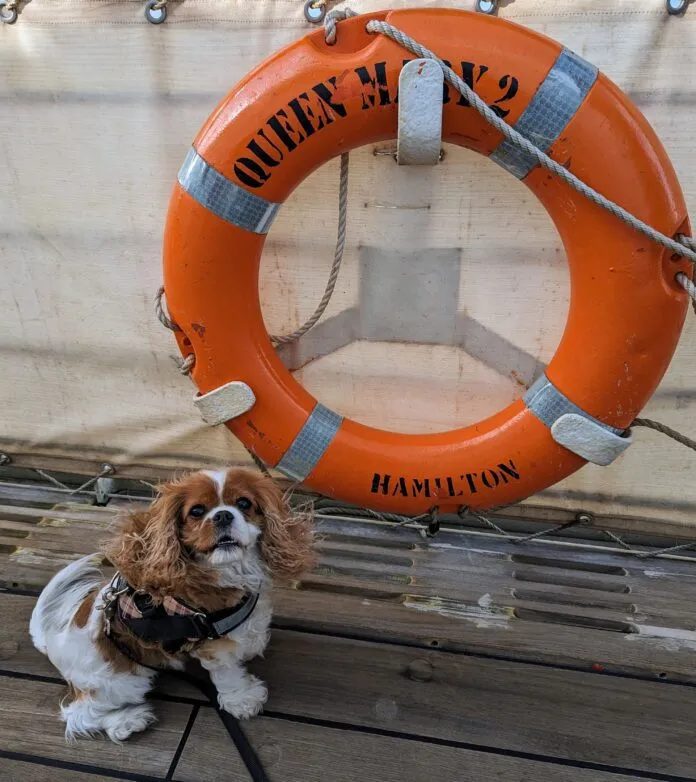
The biggest misconception about taking a dog to Europe or other overseas destinations is that a lengthy quarantine stay is mandatory. That’s old news, but there are still multiple hoops to jump through before you and your dog can jet off to an international locale, whether for a move, a vacation, or specialized pet medical care (yes, that’s a thing).
My husband and I recently put into play a longstanding plan to spend several months exploring Europe—and of course that meant taking our dog Sparkles along. Here’s what we learned about how to travel with a dog internationally, from planning to pitfalls, and how to avoid the latter. It’s not easy or inexpensive, but if you’re planning to stay for more than a month or to make a permanent move, it’s worth the effort.
Before you make travel reservations and start packing your bags, take into account the following 9 factors:
- Destination(s) and how to get there
- Size of dog and carrier
- Pet travel documents
- Packing for your pet
- Food and medication
- Where to stay
- Dog-friendly activities
- Finding a pet sitter when necessary
- Getting back home
Doing research ahead of time, especially on the first four items, will save you a lot of anxiety and, potentially, money.
I See London, I See France
Where you’re going plays a huge role in determining your mode of travel. If you’ve been dreaming of taking your dog to Great Britain and have heard that there’s no longer a six-month quarantine, that doesn’t mean that taking your dog there will be a walk in Hyde Park. Britain has strict guidelines for pet entry. On flights to the United Kingdom, pets may not fly in the cabin but must be transported in cargo. The only exceptions are specific types of assistance or service dogs. (Those requirements aren’t addressed in this article, but more information is available at https://www.gov.uk/government/publications/travel-with-assistance-dogs-transport-companies-and-routes .)
You can only enter the UK directly with your dog if you’re traveling by private jet, including pet-friendly carriers such as Bark Air, or crossing the pond on the ocean liner Queen Mary 2 , which has popular pet kennels that are generally booked a year or more in advance.
Start planning now if an Atlantic crossing is the way you want to go. Even though I knew our timeline wouldn’t allow for it, I looked into it just to see how it works. Travelers must reserve a cabin for a specific date first and then call to see if a pet kennel is available. If not, they’ll be placed on a waiting list and contacted when a spot is available. Flexibility is essential. Getting a pet spot can take up to two years or it can happen very quickly if someone cancels a reservation.
How to Travel With a Dog By Plane

Unless you have a NetJets membership, private jet charters are usually put together with a group of other pet lovers who also want to get to the UK or other destinations without flying their pets in cargo. To find potential charters, usually to the EU or UK, look for Facebook groups such as Chartered Air Travel With Pets. Finding the right charter that works for your destination and dog, not to mention budget, can take months of planning.
Bark Air has a regular schedule of flights to London and Paris and is planning to add other European destinations. It’s pricey, with flights from $8,000 and up each way, but there are no limitations on dog size. (They fly cats, too, if they’re in a carrier and vouched for by an accompanying dog.) Luggage weight is limited, so if you’re a couple or larger family planning a long stay, it makes sense for one person and pets to fly Bark Air or another charter flight, while the others fly commercial with the remaining bags.
For most people, including us, the easiest and most cost-effective way to take a small dog to the UK is to take a commercial flight to France, the Netherlands, or the Republic of Ireland—an EU member—with dog in cabin and then take a ferry or use a pet transport service through the Channel Tunnel, nicknamed the Chunnel.
Size Matters When Travelling With a Dog
Once you make your own flight reservations, call immediately to make one for your dog as well.
Most commercial airlines limit the number of pets on board per flight as well as the animals’ size and weight. Pet fees range from $100 to $200 or more each way and sometimes each leg.

At 13 pounds, Sparkles is well under most airline pet weight limits. Air France limits in-cabin dogs to 8 kilograms, or 17.6 pounds. On American Airlines, the combined weight of carrier and pet can’t exceed 20 pounds. Delta recommends checking aircraft dimensions to make sure a carrier will fit comfortably beneath the seat in front of you. They suggest maximum dimensions of 18 inches by 11 inches by 11 inches, which work for most aircraft types. A soft-sided carrier can be compacted on the top and sides to ensure a fit. For slightly larger dogs, consider La Compagnie, which flies from New York to Paris and Milan and allows dogs weighing up to 33 pounds.
Whatever airline you choose, get weight and carrier size requirements directly from its website, not from blogs or random Facebook commenters. Print a copy, bring it with you, and document any phone conversations beforehand with airline employees in case there’s an issue at check-in.
Airlines require that dogs be able to comfortably stand up and turn around inside the closed carrier. Sparkles was happy to do that at home with the enticement of a treat. Fortunately, she didn’t have to demonstrate at check-in. In 20-plus years of flying with Cavaliers, we’ve never had a gate agent ask to weigh a dog or measure a carrier, but that doesn’t mean it can’t happen.
We flew Air Canada from Los Angeles via Montreal to Toulouse, France, and expected to be in premium economy, but their planes aren’t configured to allow pet carriers in that section, so we upgraded to business class. Even that had drawbacks. With Sparkles in a carrier at my feet, it wasn’t possible to recline the seat very much and a shelf underneath the seat in front of me meant that her soft-sided carrier tended to slide forward on takeoff or whenever she moved inside it. Dogs are supposed to remain in the carrier during the entire flight, but overnight, flight attendants turned a blind eye to it being open so she could spread out more.
Documents Needed for Travelling Internationally With Your Dog
Pets need passports, too. Find requirements for specific countries at the website for the USDA’s Animal & Plant Health Inspection Service . Use the dropdown menu at the bottom of the page to select your destination and determine what your dog needs to obtain a health certificate for travel. Minimum requirements are an up-to-date rabies vaccination given at least 21 days prior to travel and a 15-digit ISO-compatible microchip for identification. Some countries such as Japan require additional testing, such as bloodwork for a rabies titer test, plus a seven-month waiting period before the dog can enter the country.
The health certificate paperwork must be completed by a USDA-accredited veterinarian and endorsed by the USDA within 10 days of travel. You can find a list of accredited veterinarians in your area on the APHIS website. Completed health certificates can be submitted to the USDA online or overnighted via Federal Express or UPS. Include an overnight return envelope to get the health certificate returned quickly in time for your trip.
If you are sending the completed paperwork to the USDA, don’t forget to include the printed rabies certificate (even though the vaccination is documented on the paperwork the veterinarian has completed) and the USDA fee of $38 to endorse the health certificate. We didn’t realize the rabies certificate needed to be included or that there was an additional fee, and it caused us an anxious couple of days as we worked with the USDA representative to get the certificate and payment to them. We were fortunate they alerted us immediately that our package wasn’t complete.
Fees for completing the health certificate can range from $30 to $50 (plus the normal cost of the veterinary visit/exam) to $750 or more. We paid $360 for Sparkles’ health certificate. Join Facebook groups such as Animal Health Certificates, Traveling With Dogs, or Travelling With Dogs in Europe/The United Kingdom to get an idea of how much fees can vary and recommendations for veterinarians who charge reasonable rates.
Bear in mind that if you are traveling to the EU and then plan to go to the UK, as we did, you will need to get an EU pet passport once you arrive in an EU country or get health certificates for both the EU and the UK and travel to the UK within 10 days from the date your dog’s health certificate is endorsed.
An EU pet passport makes it easier to travel with your dog between the EU and the UK, but it’s not always easy to get. Veterinarians in some countries such as Ireland and Belgium tend to be more willing than others to provide them. Those in France, Spain, and Portugal may require you to have an in-country address. We were fortunate to find one in France who did not make that a requirement, but we were prepared to drive to Belgium if necessary. If I had realized sooner that Ireland was an option, we might have gone that route. To find a French veterinarian, Google, Google Translate, and email were my friends.
Le Pet Express, the pet transport company we used to get from Calais, France, to the UK was invaluable in reviewing the pet passport to make sure it had been completed, dated, and stamped correctly by the veterinarian. We sent photos of the passport pages and they responded quickly as to whether they would pass inspection at the border. We had to have it redone before they were satisfied, resulting in a smooth experience. On the plus side, the veterinary fees were reasonable: $65 for the exam and passport, plus another $18 to redo the passport.
The final veterinary hurdle was a tapeworm (echinococcus) treatment required by the UK before Sparkles could enter. It had to be administered by a veterinarian at least 24 hours and no more than 120 hours before arrival and recorded in the pet passport or animal health certificate.
What to Pack for Your Dog

Here are the basics:
- Food, treats and medication
- A soft mat for a bed
- Comb, brush or other necessary grooming tools
- Wipes for cleaning
- Copies of your dog’s prescriptions
We bring a sheet to throw over furniture. Sparkles isn’t into toys, but your dog may have a favorite that should come along. Since we were going to have a car, we also brought her stroller for hot days, crowded areas, or very long walks, and her Sleepypod car seat.
As far as food, we learned during our research that importing meat-based pet food into the EU or UK was not permitted, but fish-based food was okay. Now, nobody checked Sparkles’ suitcase (yes, she had her own) to see what was in it, but to be on the safe side, we switched her to a fish-based food a month or so before departure. Once we arrived, we searched pet supply stores for foods that were similar to the freeze-dried, turkey-based food she had been eating at home. We found an assortment, especially in the UK, and she readily ate what was provided without any stomach upset.
Dog-Friendly Lodging, Restaurants, and Activities

Whether you’re staying in hotels or homes, it’s easy to find pet-friendly lodging using website filters. Always confirm before you commit.
It’s almost impossible to find restaurants that don’t allow pets, although there are a few. Sparkles went with us for dim sum in Bordeaux, traditional French in St. Emilion, and pubs in the UK. Like most of the other dogs we saw, she hung out beneath the table, sleeping or watching the passing parade. (Okay, we sneaked bites to her once in a while.)
You won’t be able to take your dog inside museums or stately homes or chateaux, but the grounds are often dog friendly. We take turns going inside, with the other person walking Sparkles or hanging out at a café with a coffee or glass of wine. Our best day was at Marble Hill, just outside London, which had vast lawns and river paths where dogs could safely walk and play off leash.

On occasion, you may need a pet sitter. When we were going to be gone all day on a tour of World War II sites in Normandy, we checked Rover to find a local pet sitter. If that hadn’t worked out, I would have skipped the tour and explored Bayeux on my own with Sparkles.
Getting Your Dog Back Home
Just before we flew to France, the Centers for Disease Control changed the entry requirements for pets returning to the United States. If you have been only in rabies-free or low-risk areas like EU member countries and the UK, complete a free Dog Import Form online. The emailed receipt can be stored on your phone. Present it on return if asked for it. You can find out more on the CDC’s website .
Bon voyage!
RELATED ARTICLES MORE FROM AUTHOR

LEAVE A REPLY Cancel reply
Log in to leave a comment
Latest Blog

A Law to Help With Veterinary Fees
- Shipping & Return Policy
- Do Not Sell My Personal Information
- Privacy Policy
- Online Account Activation
- Privacy Manager
By using this website, you consent to our use of cookies. For more information on cookies see our Privacy Policy Page Close
Bringing Your Pet Dog, Cat or Ferret into Ireland from Outside the EU From Certain Listed Countries
- There is a change in the pet travel rules coming on 16/09/24. If you and your pet are arriving from Belarus or Russia on or after 16/09/24, please disregard the rules on this page and instead follow the rules here: Pet Travel: Other
The pet must arrive in Ireland with their owner. If the owner cannot travel with the pet directly, then someone else (an authorised person) may travel with the pet directly on the owner’s behalf, BUT only if the owner’s own journey is within 5 days of the pet/authorised person’s journey.
- All pets must be accompanied by original paperwork, not copies.
- Five is the maximum number of animals allowed to travel with you under the pet travel rules. These rules apply no matter which country you are travelling from.
It is up to each individual airline to decide whether to carry the animal in the cabin or as excess baggage – the Department of Agriculture, Food and the Marine does not decide on this. There is no ban on the carriage of pets in cabin into Ireland
- Service animals must comply with the rules on EU pet travel.
It is important to note that it is the country the pet is currently travelling from that sets the entry requirements, not the country the pet was born in or normally resides in. This means that if an Irish pet goes with its owners on holidays to Brazil and then wants to re-enter Ireland, it must follow the rules below on entry from Brazil. Irish/EU citizens should always prepare their pet for re-entry to Ireland BEFORE they leave Ireland.
It is also important to note that EU pet passports must be properly and fully completed to be valid for travel. Simply having one does not allow your pet automatic entry into Ireland, they must still abide by the rules below.
- If you are entering Ireland from a non-EU country Ireland you must give advance notice of your intention to bring your pet into Ireland and arrange in advance to have a compliance check carried out on arrival. You must not leave the airport or port before compliance checks are carried out.
Please read through the information below carefully. If you have any questions on pet travel after reading, please contact:
Email address: [email protected]
- telephone from within Ireland: 01 607 2827
- telephone from outside of Ireland: 00353 1 6072827
Coming From One of The Countries/Territories Listed Below:
1. been microchipped.
The microchip must be inserted before the rabies vaccination is administered, and must be readable by a device compatible with ISO standard 11785. If the microchip cannot be read when you enter Ireland, your pet could be put into quarantine under official control or refused entry. You may bring your own microchip scanner, if the microchip is not readable by a device compatible with ISO standard 11785.
2. A Valid Rabies Vaccination
- The vaccination must be given after the microchip is inserted.
- The pet must be at least 12 weeks old before the vaccination is given, and it must be given by a vet authorised by the authorities of your country.
- You must wait until the appropriate immunity has developed, as stated by the datasheet of the vaccination given, which must be at least 21 days after the primary vaccination is given, before you can bring the dog, cat or ferret to Ireland. If the datasheet of the vaccination used says that immunity is not present until day 30 after vaccination, then you must wait 30 days before travel and your vet should record the same in the health certificate.
A rabies vaccination with a 1 or 3-year validity period is acceptable for entry into Ireland, but please see explanations below re primary vs booster.
Once there has been no break in coverage after a primary rabies vaccination, subsequent vaccinations are considered booster and not primary vaccinations.
If there has been a break in coverage, the next vaccination will be considered a primary vaccination and the appropriate waiting period will apply. This is especially important to travellers from North America. Please see rabies vaccination sections on the following websites...
USDA website
Canada website
In the case of booster vaccinations, the waiting period does not apply.
If you are unsure, or do not see your country listed here, please check EU rules on travelling with pets and other animals in the EU - Your Europe (europa.eu) to see if your dog, cat or ferret requires a rabies antibody test in addition to a rabies vaccine. If so, please read the requirements on Pet Travel: Other
All dogs, cats and ferrets entering Ireland must comply with these requirements. There are no exemptions to this rule. If you are travelling from an area which has been declared rabies-free, your dog, cat and ferret still needs to comply with the rabies vaccination requirements.
3. Is Accompanied by a Valid EU Pet Passport or EU Health Certificate .
Ireland accepts pet passports from all EU countries, Northern Ireland and from the following European countries/territories:
Andorra, Gibraltar, Greenland and the Faroe Islands, Iceland, Liechtenstein, Monaco, Norway, San Marino, Switzerland, Vatican City State
A valid passport is a passport issued by an EU country or a country/ territory listed above, which certifies that the rabies vaccine given is valid.
Vets in countries outside of the EU and the countries/territories listed above may not complete, sign or stamp the section on rabies vaccination in the passport. If they were to do so, this would make the pet passport invalid for travel.
If your pet dog, cat or ferret does not have a pet passport issued by an EU country or the countries/territories listed above, it must be accompanied by an EU Health certificate before entering an EU country, including Ireland.
An EU Health certificate must be:
- completed by your veterinary practitioner, AND
- signed and endorsed by an Official (State) Veterinarian of the country of departure, within 10 days of pets arrival into the EU, AND
- immediately upon arriving into the EU, signed and endorsed by the EU country which performed the compliance checks
An Official State Veterinarian is a veterinarian directly employed by the government in the country of departure.
If the pet is travelling by sea, the validity is extended by the number of days of travel by sea.
The endorsed certificate is valid for travel between EU Member States for up to 4 months, or until the anti-rabies vaccination expires, whichever is the earliest. Please note this is between EU Member States only, and not to travel out of the EU and back in again. If the pet leaves the EU at any stage, then a new health certificate signed by an official vet within the last ten days is required to re-enter the EU, and all the other rules re vaccination and tapeworm etc will apply.
4. Has Been Administered Tapeworm Treatment for Dogs
If your dog is entering Ireland from any country apart from Finland, Malta, Norway or Northern Ireland, a vet must treat your dog for tapeworm (specifically Echinococcus multilocularis) and record the treatment in the pet passport or EU health certificate before each time you intend to travel to Ireland.
The treatment must contain praziquantel and must be administered by a veterinarian no less than 24 hours (1 day) and no more than 120 hours (5 days) before the scheduled arrival time of the dog in Ireland. Your dog may be refused entry into Ireland or quarantined under official control if it has not been correctly treated against Echinococcus multlocularis before entry into Ireland.
5. Pet Dogs, Cats and Ferrets from the Above Countries May Only Enter Ireland Through Cork Airport, Dublin Airport, Dublin Port, Shannon Airport, The Port of Cork at Ringaskiddy or Rosslare Europort and Must Undergo Compliance Checks on Arrival.
It is your responsibility to ensure that your animal undergoes the compliance check.
Only in the event of an airport/port emergency should you leave the baggage reclaim area or point of entry without undergoing a compliance check. If this was to happen, you must contact DAFM immediately to explain why you left and re-arrange the compliance check.
If arriving into Dublin Port or Rosslare Port from Great Britain, please note special arrangements in the port may apply. Please follow the instructions given to you at the time.
- There is a fee for compliance checks on pets entering Ireland from most countries outside the EU. There is no charge for compliance checks on pets entering from Great Britain. There is no charge for compliance checks on guide dogs and assistance dogs. Guide dogs and assistance dogs are dogs trained by an organisation accepted by or affiliated to Assistance Dogs International or the International Guide Dog Federation. These dogs must travel with an identification card or a letter provided by the accredited or affiliated organisation in order to avail of a free compliance check.
Compliance checks are usually performed at the port or airport of arrival.
If you are arriving into Dublin Airport only, and your pets are travelling cargo or outside of DAFM staffs working hours in Dublin Airport (7.00am, - 9pm), the compliance check will be carried out by either:
Lissenhall Kennels [email protected] +353 1 8401776
Vets Direct [email protected] + 353 87668 6278 6278 (pets travelling cargo only)
A fee for checks will apply, please contact your chosen provider directly for details.
Please note: Checks carried out by Lissenhall may be carried out in Lissenhall Kennels or in the airport. Please contact Lissenhall for details on where the pet will be checked. Lissenhall Kennels is located approximately 10km from Dublin airport. If the compliance check is to be completed at Lissenhall, pets will be securely transported to Lissenhall Kennels; owners are not allowed to travel in the vehicle with the animal. Owners must make their own arrangements to travel to Lissenhall, at their own expense, in order to collect their animals.
The office hours in Shannon Airport are 08.00 – 16.00 Mon – Friday , arrivals outside of these hours are dependent on availability, you must contact DAFM Staff in Shannon Airport [email protected] in advance to confirm the arrival can be facilitated.
6. You Must Provide Advance Notice and Organise Compliance Checks for Your Pet in Advance of Your Arrival into Ireland.
Please click here to fill in this form Advance notice
- Pets transiting through other EU Member States may have the compliance check carried out at the first point of entry into the EU OR in Ireland. If the compliance check was performed in another EU Member State, you should produce proof of this on arrival into Ireland.
If you originally came from outside the EU and a compliance check was not carried out in another EU Member State, then you must have a compliance check on arrival into Ireland.
Pets Failing Compliance Checks
If you do not follow these rules, or your pet fails the compliance checks, it may be refused entry into Ireland, or may be placed into quarantine under official control for the necessary tests or vaccinations. In very limited circumstances, the pet may be euthanised. These measures will be implemented at the owner’s expense.
Contact Details at Points of Entry
Dublin Airport: If you need to contact a Department of Agriculture officer on arrival in Dublin Airport, you may do so by pressing the button marked Duty Supervisor on the courtesy telephone outside the Department of Agriculture offices in the baggage reclaim hall, opposite
- carousel No. 6 in Terminal 1, or
- carousel No. 2 in Terminal 2
Telephone number: + 353 (0)1 6157680.
Shannon Airport: on arrival you should pass through passport control and present your animal to the Department of Agriculture in the Arrivals Hall. You must not leave the baggage reclaim hall without undergoing the compliance check. If the inspector is delayed please take a seat and await their arrival.
Officers will be available from 08.00 to 16.00 . If you arrive earlier than 08.00, please wait in the baggage hall.
If you need to contact us or cancel the inspection please call the Portal Inspector on Duty on +35361500940 or by emailing [email protected] .
If you need to contact DAFM staff in Shannon Airport or cancel the inspection please call the Portal Inspector on Duty on +35361500940 or by emailing [email protected] .
If any of the following situations apply to you:
- you are buying a dog, cat or ferret abroad and having it shipped to Ireland, that is, you are not going to collect it and travel home with it, or
- your pet is in another country and you want to have it shipped to Ireland, that is, you are not going to collect it and travel home with it
- you are travelling to Ireland to buy, sell or gift a dog, cat or ferret, or if any change of ownership is involved after arrival, including delivery of a purchased or rehomed animal
- if you are travelling with more than 5 pets (the exception is if you are travelling for a show/competition, and you will need to provide written confirmation [email protected]
then your pet may not enter Ireland under pet travel rules. These pets must follow a different set of rules as only pets travelling directly with their owners can use the pet travel rules for entry. Please see section on Bringing an Unaccompanied Pet Cat, Dog or Ferret into Ireland.
Your Search Criteria
Office hours.
Monday - Friday 9.00 - 17.00
Saturday Closed
Sunday Closed
Lo-call 0761 064 400
Call us on 01 607 2000
Email: [email protected]
Make An Enquiry
Agencies & helpful resources.
- | Copyright 2021 Department of Agriculture, Food and Marine
- | Privacy Policy
- | Legal Notices
- | Sitemap
- | Contact Us
Are you sure you want to sure you want to leave the feed?
Oops... something went wrong!
Looking for inspiration? Planning a trip? Or just want to scroll yourself happy? We'll show you an Ireland that's tailor-made for you.
- #Landscapes
- #CultureandHeritage
- #OutdoorActivities

Oops, no internet connection
While offline, you can still add items to ‘My Board’. New travel reccomendations will only show up once you’re back online.
See what Ireland has in store for you
Items without a physical location are not shown in map view.
Looks like your board is empty
Look out for the little heart icon around Ireland.com, simply tap the icon to start adding items to your board!

Board settings
Collection cover image.
Visible to people you share your board with
Share Board
Share a link to your ‘My Ireland’ board and inspire friends, co-travellers and family. Only you can add or remove items from your board.

Forgot your password?
Create an account.
Access My Ireland across all of your devices by logging in.
Sign up Not got an account?
Terms of use | Privacy policy
Login Got an account?
Location access
- View offers and deals nearby you
- Get travel inspiration based on your location
- Local weather warnings and useful travel information
Enable location access
Location access on ios.
- 1 Open the website settings for this website in your browser
- 2 Select Location settings
- 3 Choose “Allow
- 1 Open the My Ireland website

- 2 Select the Icon below

- 3 Select “Website Settings

- 4 Change “Location” to “Allow”

Notifications
Travel times.
Tell us when you are going to be travelling Ireland, and we will show you tailored recommendations for the duration of your trip.

- Tips for events happening during your stay
- Helpful travel reminders and updates
You have unsaved changes. Save before leaving?
We take your privacy very serious and only ever process your data with your persmission. If possible this is handled anonymously and we will never store your data for longer than is required. For more information on how we handle your personal data please read our Privacy Policy.
Remove Data
To securely remove all data associated with your profile please contact our Data Protection Officer.
Reset your Board
This will remove all the items you have previously liked from your board. Please note, you can’t undo this action.
Are you sure you want to reset your board?
This will completely reset your board and all associated data permanently. This cannot be undone.
- Created date 16 July 2024
Details saved! Thank you!
Sorry we've encountered an issue. Please try again later.
Delete account
Sorry you’re leaving. But you gotta do what you gotta do. Just a reminder, if you delete your account, you won’t be able to post in Community. And it’s permanent so you can’t “undo” it in the future.

Bringing your pet to Ireland
The importation of pets into Ireland is strictly controlled to ensure diseases such as rabies are kept off of the island

Ireland in your inbox
Sign up to receive free email newsletters from Tourism Ireland, including vacation ideas, insider tips, news, and events.
We will use your email address to send you personalised content straight to your inbox based on how you interact with this website and our advertisements on other websites.
Something went wrong...
Success! Thank you for subscribing to our Newsletter!
I understand that by signing up, I will receive personalised email content based on my use of Tourism Ireland’s website, emails and Tourism Ireland’s advertising on other websites, cookies and tracking pixels. You can unsubscribe at any time by clicking 'unsubscribe' in our emails. Find out more information on "How we handle your personal data" in our privacy policy .
I would like to receive information and special offers by email from carefully selected travel partners. For more information please see our privacy policy .
Bringing your pet on holiday with you is fun – they’re part of the family after all. Selected hotels, guest houses and B&Bs happily accommodate pets: the five-star Cliff House Hotel in County Waterford even offers a luxury package specially designed for your pooch. B&B Ireland has lots of members who accept pets into their homes and many self-catering properties are now pet-friendly.
For the enthusiastic dog owner, the possibilities for walks are endless on the island – although remember to keep your dog on a leash at all times as sheep can pop up out of the most unlikely places! During the summer months, country fairs and festivals hold all sorts of dog shows, cat shows and pet races; so if you’re particularly proud of your pooch why not see if they can bring home the gold?

Murlough Bay
County Antrim
For the enthusiastic dog owner, the possibilities for walks are endless on the island
Bringing pets into the Republic of Ireland
Entry requirements depend on where your pet is travelling from .
Travelling from the EU
If you are bringing your pet dog, cat or ferret into the Republic of Ireland from another EU country or from Andorra; Gibraltar; Greenland and the Faroe Islands; Iceland; Liechtenstein; Monaco, Norway; San Marino; Switzerland or the Vatican City State, your pet must:
• Be microchipped (this must be done before anything else)
• Have a valid rabies vaccination
• Have an EU Pet Passport or Health Certificate
• Be treated for tapeworm (dogs only) before each visit, unless you’re travelling from Northern Ireland, Finland, Malta or Norway)
Travelling from Great Britain
If you are bringing your pet dog, cat or ferret into the Republic of Ireland from Great Britain, your pet must:
• Have an Animal Health Certificate
• Be treated for tapeworm (dogs only)
Allow plenty of time to arrange the relevant vaccinations and requirements with your vet before you travel – and don’t forget your pet will need a new AHC and tapeworm treatment for each trip. Find out more at Gov.uk: Taking your pet abroad and Gov.ie: Pet Travel Portal .

Dogwalking at Portumna Castle, County Galway
Travelling from outside the EU and Great Britain
Entry requirements depend on your country of origin. You can find details of the requirements for each country on the Irish Government's Pet Travel Portal .
At a minimum, your pet must:
- Be microchipped (this must be done before anything else)
- Have a valid rabies vaccination
- Have an EU Health Certificate
- Be treated for tapeworm (dogs only) before each visit
- Enter the Republic of Ireland only through Cork Airport, Dublin Airport, Dublin Port, Shannon Airport, the Port of Cork at Ringaskiddy or Rosslare Europort and must undergo compliance checks on arrival.
Pets coming from certain countries may also need to have a blood test after the rabies vaccination at least three months before entry.
Advance notice: If you're entering Ireland from a non-EU country you must arrange in advance to have a compliance check carried out on your arrival. You can find contact details to make these arrangements on the Pet Travel Portal .

Castlewellan Forest Park, County Down
Bringing pets into Northern Ireland
Dogs, cats and ferrets from certain countries or territories can enter Northern Ireland without quarantine provided they meet certain criteria.
Northern Ireland is part of the EU Pet Travel Scheme so you can use a pet passport issued in an EU country, including the Republic of Ireland, to bring your pet into Northern Ireland. Your pet will need to:
- Have an EU Pet Passport or Health Certificate
- Be treated for tapeworm (dogs only) before every visit
Great Britain is outside the EU Pet Travel Scheme so there are different rules around bringing your pet to Northern Ireland from Great Britain. Before you travel, you should check the Northern Ireland Government website or Gov.uk: Taking your pet abroad to make sure you adhere to the latest requirements.
Entry requirements depend on your country of origin. You can find details of the requirements for each country on the Northern Ireland Government's website .
- Have an EU Health Certificate confirming microchip and vaccinations
- Enter Northern Ireland only through Belfast Port, Belfast International Airport, Belfast City Airport, City of Derry Airport or Larne Port and may be required to undergo compliance checks on arrival.
Travelling within the island of Ireland
Pets travelling from the Republic of Ireland to Northern Ireland or vice versa should be microchipped, vaccinated against rabies and meet any additional requirements. They must also be accompanied by either a valid Animal Health Certificate (Great Britain residents) or an EU pet passport.
Getting here: transport and your pet
It's up to each individual airline to decide whether to carry your pet in the cabin or as excess baggage and each ferry operator has differing rules on travelling with animals. Always check with your transport company before you travel to confirm their requirements for transporting your pet.
Welcome Back
Don't have an account yet? Register
Are you a business owner? Register here
Already have an account? Log in
The Easiest Way To Travel From Ireland To Spain With A Dog
Updated On: February 05, 2024 | Published On: August 04, 2021
Can I bring my dog to Spain from Ireland?
How to travel to spain with a dog.
- By Air : If you choose to fly, ensure that your dog meets all the requirements for air travel. Not all airlines allow dogs in the cabin, to find a full list check out our blog on European airlines that welcome dogs in the cabin .
- By Ferry - Direct to Spain : When taking a dog-friendly ferry to Spain, you have two different options, either the Ireland-Spain route of Rosslare to Bilbao (which is located in the Basque Region of Spain) or the Rosslare to Santander route.
- By Ferry via France : There is also the another option of taking one of the pet-friendly ferry crossings to France. You can catch the ferry from Rosslare to Cherbourg or Cork to Roscoff and then enjoy the miles of driving through France countryside until you cross into Spain by the Pyrenees.
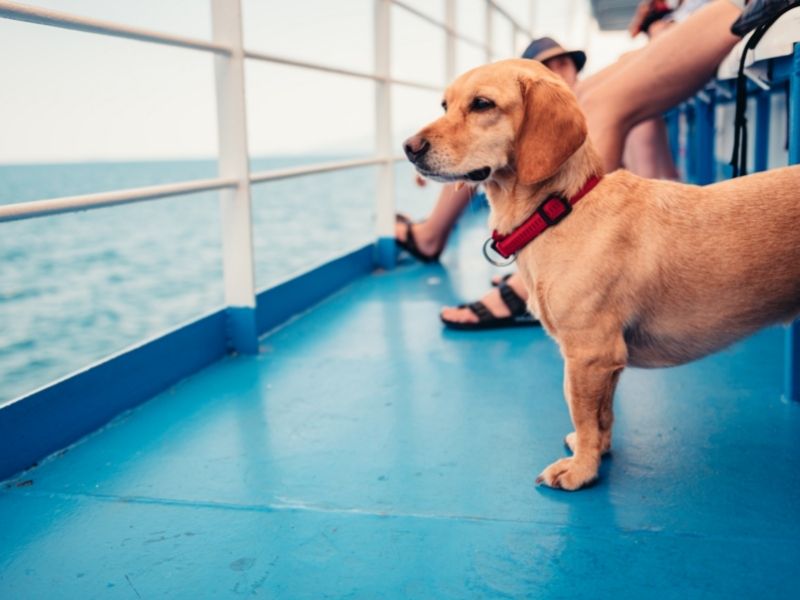
Is Spain dog friendly?
Flying a dog to spain, is it possible, can dogs go on the ferry to france.
- Foot and car passengers are allowed to bring pets on this journey, but it is important to know that on the return trip (from Cherbourg to Ireland), car passengers must first go to the terminal building before the car check-in point so that your dog's microchip details can be checked.
- Brittany Ferries : Brittany Ferries offers dog-friendly cabins for their ferry routes between Ireland and France. They run a ferry service between the port of Cork and Roscoff and Rosslare and Cherbourg. You are not able to bring your pet if you are a foot passenger or traveling by bike.

Does Brittany ferries offer pet friendly cabins?
Is there a direct ferry route from ireland to spain, what are the ferry timetables , how much is the ferry from ireland to spain, where is my dog allowed to go on the boat.
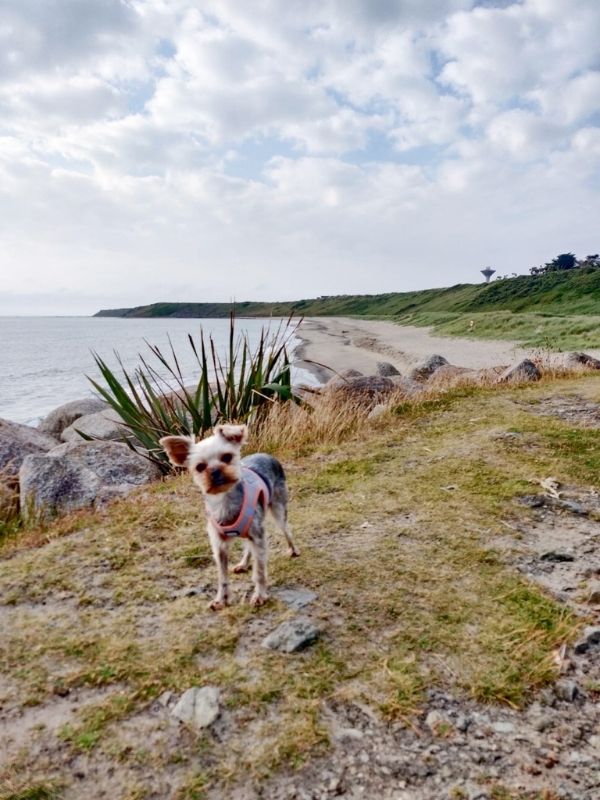
What paperwork do I need for my dog in order to travel from Ireland to Spain by ferry?
Pre-ferry checklist for traveling from ireland to spain, what to bring on the ferry.
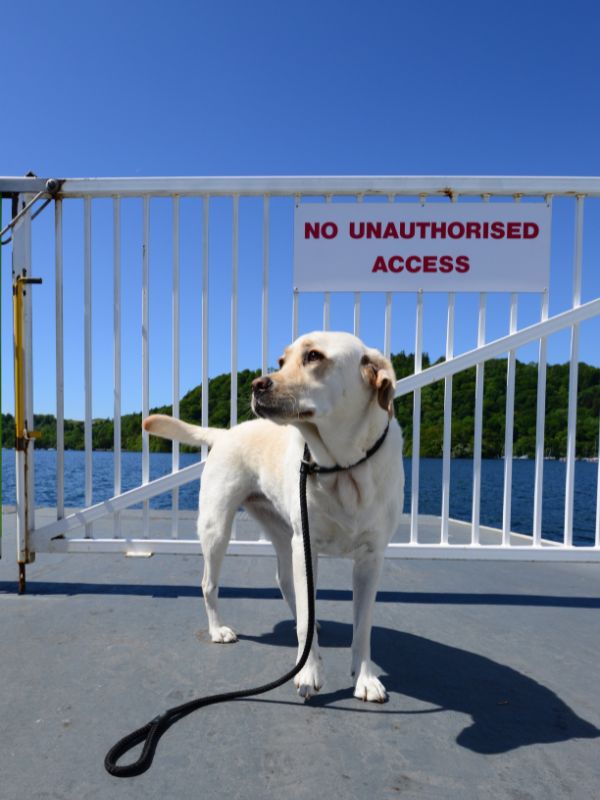
Boarding the Boat
During the trip, our experience, latest posts.
The 240 Best (male) Dog Names that Mean Love
February 12, 2024
12 Dog Friendly Hiking Trails in San Antonio 2024
January 09, 2024
Santa Paws Events This Christmas in Great Britain 2023
November 20, 2023
Where to see Santa Paws in Northern Ireland 2023
November 15, 2023
Visit Santa Paws in Ireland 2023
November 13, 2023
Top Dog-Friendly Topics
Ireland (55), lifestyle (21), dublin (19), places to eat (15), places to stay (14), hotels (14), restaurants (11), things to do (10), recent posts, sign up for our dog-friendly newsletter.
Stay up-to-date with our latest articles and recommendations on dog-friendly businesses worth visiting. 🐶
Let's Get Social
Follow for new ideas to explore with your pup and make sure to tag us in your dog-friendly adventures! 🐶
Pamper Your Paws
Top local services for your pet are just a click away! 🐾 Dive into our services tab now. 🐶
View All Services
- Zur Navigation
- Zum Seiteninhalt
- Zu verwandten Seiten
- Zur Inhaltssuche
Seiteninhalt
Beförderung von tieren im flugzeug.
Auf Lufthansa-Flügen können Sie Ihren Hund oder Ihre Katze mitnehmen. Bitte lesen Sie die folgenden Informationen sorgfältig, bevor Sie Ihre Reise mit Tier buchen.

Eine gute Reise für Ihre Liebsten
Je nach Art, Gewicht und Größe Ihres Tieres sowie den gültigen Länderbestimmungen ist der Transport gegen Gebühr entweder als zusätzliches Handgepäck in der Passagierkabine oder als Übergepäck im klimatisierten Frachtraum des Passagierflugzeugs möglich. Zusätzlich bietet Lufthansa Cargo den Transport von diesen und anderen Tierarten als Luftfracht an. Für Assistenzhunde gelten Sonderregelungen. Bitte beachten Sie, dass aufgrund von örtlichen Gegebenheiten und Einschränkungen der Transport von großen Tieren im Frachtraum zu bestimmten Zielen nicht möglich ist.
Neue Einreisebestimmungen für Hunde in die USA
Die Einreisebestimmungen für Hunde in die USA haben sich zum 01. August 2024 geändert.
Basierend auf den neuen Anforderungen der amerikanischen Gesundheitsbehörde Centers for Disease Control and Prevention (CDC) können derzeit Neubuchungen für Hunde in die USA nur nach Atlanta, Los Angeles, Miami, New York-JFK, Philadelphia und Washington DC angenommen werden.
Tiertransporte als Luftfracht zu anderen Destinationen sind auch weiterhin möglich. Bitte wenden Sie sich hierfür an einen Tierspediteur.
Wir bitten Sie, sich mit den neuen Anforderungen rechtzeitig vertraut zu machen.
Zur Vorbereitung der Reise Ihres Hundes, müssen Sie u.a. das von den amerikanischen Behörden bereitgestellte Formular „CDC Dog Import Form“ online ausfüllen. Nachdem Sie dieses Formular abgeschickt haben, wird eine Bestätigung an die von Ihnen angegebene E-Mail-Adresse gesendet. Am Tag der Abreise und bei der Einreise in die USA müssen Sie diese Bestätigung in digitaler oder ausgedruckter Form vorlegen.
Sollten Sie die CDC-Anforderungen nicht erfüllen, müssen wir Ihnen leider mitteilen, dass Ihnen die Beförderung verweigert wird.
Wir danken Ihnen für Ihr Verständnis.
Bereits bestätigte Buchungen werden nach dem 1. August 2024 anerkannt, sofern alle CDC-Anforderungen erfüllt werden können. Vollständige Angaben zu den Anforderungen finden Sie auf der CDC-Website.
Es liegt in der Verantwortung des Fluggastes, alle Anforderungen zu erfüllen. Werden die von der CDC geforderten Dokumente beim Check-in nicht vorgelegt, wird die Beförderung verweigert.
Wir bieten weiterhin folgende Möglichkeiten an, sofern die Buchung eines Hundes bereits vor dem 3. Juli 2024 bestätigt wurde.
- Umbuchung ohne die Mitnahme eines Hundes
- Erstattung des Flugscheins
Bei weiteren Anliegen werden Fluggäste gebeten, sich mit unserem Service Center in Verbindung zu setzen.
Die Beförderung von Assistenzhunden ist unter Einhaltung der neuen CDC-Vorgaben auch weiterhin möglich, vorausgesetzt alle CDC-Anforderungen werden erfüllt. Vollständige Angaben zu den Anforderungen finden Sie auf der CDC-Website. Es liegt in der Verantwortung des Fluggastes, alle Anforderungen zu erfüllen. Werden die von der CDC geforderten Dokumente beim Check-in nicht vorgelegt, wird die Einfuhr/Beförderung verweigert.
Sollten Fluggäste bereits eine bestätigte Buchung für sich und ihren Assistenzhund haben, bitten wir, sich mit unserem Service Center in Verbindung zu setzen.
Welche Reisemöglichkeiten gelten für welche Tiere?
Die Transportmöglichkeiten für Tiere bei Lufthansa richten sich nach Art, Gewicht und Größe des Tieres. Weitere Informationen finden Sie auf dieser und den folgenden Seiten.
Ausschließlich kleinere Hunde und Katzen, die inklusive des Transportbehälters nicht mehr als 8 kg wiegen, können unter bestimmten Voraussetzungen als zusätzliches Handgepäck in der Flugzeugkabine transportiert werden. Nicht erlaubt in der Kabine sind größere Hunde und Katzen sowie alle anderen Tierarten, unabhängig von deren Gewicht und Größe. Eine Anmeldung muss bis spätestens 72 Stunden vor Abflug erfolgen. Andernfalls kontaktieren Sie bitte bis zu 24 Stunden vor Abflug das Service Center. Darüber hinaus behält sich Lufthansa vor, ggf. striktere Regeln geltend zu machen und für bestimmte Strecken (wie z. B. Großbritannien, Irland) die Reservierung abzulehnen, um die Mitnahme des Tieres auszuschließen.
Für die Mitnahme eines Tieres als Handgepäck in der Kabine benötigen wir eine Bestätigung von Ihnen, dass das Tier die genannten Voraussetzungen erfüllt. Bitte legen Sie dafür zwei Ausdrucke des vollständig ausgefüllten und unterschriebenen Formulars am Check-in Schalter vor.
Bitte beachten Sie, für Assistenzhunde auf direkten Flügen von/nach USA wird das Formular nicht benötigt.
Hunde und Katzen, die inklusive des Transportbehälters schwerer als 8 kg sind, können unter bestimmten Voraussetzungen als Übergepäck im klimatisierten Frachtraum der Maschine transportiert werden. Eine Anmeldung muss bis spätestens 72 Stunden vor Abflug erfolgen. Andernfalls kontaktieren Sie bitte bis zu 24 Stunden vor Abflug das Service Center.
Für die Beförderung aller anderen Tierarten wenden Sie sich bitte an Lufthansa Cargo.
Auf Lufthansa Flügen können Sie Ihren Assistenzhund kostenlos mit an Bord nehmen. Bitte informieren Sie sich über die allgemeinen Voraussetzungen zur Mitnahme eines Assistenzhundes in der Kabine.
Für die Mitnahme von Kampfhunden gelten gesonderte Bestimmungen.
Hunde und Katzen, die zu den stumpfnasigen Rassen gehören, haben anatomisch bedingt verengte Luftwege und damit einhergehend Atemnot. Deshalb gibt es für den Transport dieser Tiere besondere Hinweise und Bestimmungen.
Wenn Sie nicht zusammen mit Ihrem Tier reisen können, die Länderbestimmungen den Tiertransport per Luftfracht vorschreiben oder ein auf lufthansa.com nicht aufgeführtes Tier transportieren möchten, besteht die Möglichkeit, Ihr Tier als Luftfracht befördern zu lassen. Für den Versand als Luftfracht (z.B. mit Lufthansa Cargo) gelten abweichende Preise. Sie benötigen hierfür einen auf Tiertransporte spezialisierten Spediteur. Über die Tierspediteur-Suche erhalten Sie einen Kontakt in Ihrer Nähe. Sollten Sie hierzu Fragen haben, hilft Ihnen das Lufthansa Cargo Service Center gerne weiter, in Deutschland unter 0180 6 – 747 100 (Kosten 0,20 €/min. für Anrufe aus dem deutschen Festnetz; Kosten max. 0,60€/min. für Anrufe aus Mobilfunknetzen).
Grundsätzliche Hinweise für die Beförderung von Tieren auf Lufthansa Flügen
Bitte beachten Sie das Mindestalter der reisenden Tiere. Für Hunde und Katzen beträgt das Mindestalter:
- bei Reisen von/nach/über Deutschland 15 Wochen.
Bitte informieren Sie sich unbedingt frühzeitig und vor der Buchung Ihres Fluges über die für Ihr Tier gültigen Ein- und Ausfuhrbestimmungen des Abflug-, Transit- und Ankunftslandes, z.B. beim Konsulat. Erkundigen Sie sich bitte auch bei Ihrem Tierarzt über die gültigen Tierschutzbestimmungen für die Reise mit Ihrem Tier. Besorgen Sie sich alle erforderlichen Reisedokumente für Ihr Tier, damit der Reise nichts im Wege steht.
Falls Lufthansa die Beförderung des Tieres verweigern muss, weil die Bestimmungen nicht eingehalten wurden, haftet Lufthansa nicht für die sich daraus ergebenden Kosten (z. B. Umbuchungsgebühren, Unterbringung im Tierheim, Hotelübernachtung).
Lufthansa behält sich ebenfalls vor, den Transport von Tieren im Frachtraum bei extremen Wetterbedingungen am Zielort abzulehnen. Dies kann kurzfristig oder saisonal erfolgen.
Bitte beachten Sie: jedem Passagier ist es erlaubt, maximal 2 Tiere (in einem zulässigen Transportbehälter) mit sich zu führen. Der Transport kann in der Kabine und/oder im Frachtraum erfolgen:
- 2 Tiere derselben Tierart in der Kabine in einer Transporttasche, oder
- 1 Tier in der Kabine und 1 Tier im Frachtraum, oder
- 2 Tiere im Frachtraum in 2 separaten Transportbehälter, oder
- 2 Tiere derselben Tierart im Frachtraum in einem Transportbehälter.
Für den Transport von mehreren Tieren in einem Transportbehälter gelten besondere Tierschutzvorschriften:
- Maximal dürfen 2 erwachsene Tiere von vergleichbarer Größe, die aneinander gewöhnt sind, und mit einem Gewicht von je bis zu 14 kg in einem Käfig reisen.
- Bis zu 3 entwöhnte Welpen oder Kätzchen dürfen in einem Transportbehälter reisen, wenn sie aus einem Wurf stammen, nicht älter als 6 Monate sind, und jeweils nicht mehr als 14 kg wiegen. Bitte informieren Sie sich über ggf. abweichende Ländervorschriften.
Lufthansa akzeptiert keine trächtigen Tiere.
Aufgrund der Tollwutgefahr gibt es aktuell Beschränkungen für den Import von Hunden in die USA. Detaillierte Informationen zu diesen CDC-Beschränkungen und der Möglichkeit einer Ausnahmegenehmigung finden Sie auf der Homepage des United States Center for Disease Control.
Sollten Sie eine bestehende Buchung mit einem bestätigtem Transport eines Hundes haben, kontaktieren Sie bitte unser Service Center.
Für neue Buchungen beachten Sie bitte die neuen Transportbeschränkungen. Weitere Information zu diesen Beschränkungen und die Möglichkeit eine Ausnahmegenehmigung zu erhalten finden Sie auf der Homepage des United States Center for Disease Control.
Die Beschränkungen gelten für alle Hunde, die via Flugzeug in die USA transportiert werden, inklusive Assistenzhunde.
Weitere Informationen zu den Transportbeschränkungen finden Sie hier:
Alle hier genannten Bestimmungen gelten ausschließlich für Flüge, die von Lufthansa durchgeführt werden. Bitte prüfen Sie daher bei Codeshare-Flügen unbedingt die Bestimmungen der Fluggesellschaft, die den jeweiligen Flug durchführt. Sollten Sie mit mehreren Fluggesellschaften reisen, lassen Sie sich von allen beteiligten Fluggesellschaften bestätigen, dass Ihr Tier auch dort akzeptiert wird.
Ihr Tier muss rechtzeitig angemeldet und von Lufthansa bestätigt worden sein, d.h.:
- bis zu 72 Stunden vor Abflug online oder über Ihr Reisebüro, oder
- spätestens 24 Stunden vor Abflug im Lufthansa Service Center.
Für Assistenzhunde gilt die Frist von 48 Stunden vor Abflug.
Da die Kontingente begrenzt sind, empfehlen wir eine frühzeitige Reservierung des Tieres, am besten schon mit der Buchung Ihres Fluges.
- Gewöhnen Sie Ihr Tier nach Möglichkeit bereits zu Hause an den Transportbehälter, indem Sie das Tier mehrfach jeweils etwa zwei Stunden in den verschlossenen Transportbehälter setzen und es anschließend belohnen.
- Viele Tiere sind vor und während einer Flugreise sehr nervös. Trotzdem sollten Sie sich überlegen, ob Sie Ihr Tier mit Medikamenten ruhigstellen wollen. Die Reaktionen des Tieres sind dann nicht abzusehen. Es kann z. B. während des Fluges zu Kreislaufproblemen kommen. Sprechen Sie hierzu bitte mit Ihrem Tierarzt.
- Legen Sie eine "Schmusedecke" und das Lieblingsspielzeug in den Transportbehälter, um das Tier durch den vertrauten Geruch zu beruhigen.
- Erkundigen Sie sich bei Ihrem Tierarzt, wie Sie die Nahrung des Tieres ggf. auf die Flugreise abstimmen können.
Für alle Gäste mit Tieren ist der online und mobile Check-in 30 Stunden vor Abflug möglich. Die Bordkarte muss am Check-in Schalter am Flughafen abgeholt werden.
Gerne können Sie Ihre vierbeinigen Begleiter auch in unsere Lounges mitnehmen. Bitte haben Sie jedoch Verständnis dafür, dass sich Ihre Hunde oder Katzen aus Rücksicht auf unsere anderen Gäste nicht frei in den Lufthansa Lounges bewegen und in ihrer Transportbox oder -tasche auf die Weiterreise warten dürfen. Ausgenommen von dieser Regelung sind Assistenzhunde.

IMAGES
COMMENTS
Your pet must arrive in Ireland with you, or within five days before or after you travel, if it is accompanied by a person authorised by you. Your pet must be accompanied by original paperwork. The maximum number of pets that can travel with you is 5 pets. Please see Irelands pet travel website at gov.ie - Pet Travel (www.gov.ie) for full details.
Traveling between US and Ireland with a dog in cabin. Since Zoe is only 5lb/2kg she is quite tote-able and can travel with me in the cabin. We fly Delta, we find them to be the most pet-friendly in-cabin airline. Zoe flew frequently with us domestically in the US before our move to Ireland. Pet Reservations with Delta Airlines
Northern Ireland is part of the EU Pet Travel Scheme so you can use a pet passport issued in an EU country, including the Republic of Ireland, to bring your pet into Northern Ireland. Your pet will need to: Be microchipped (this must be done before anything else) Have an EU Pet Passport or Health Certificate. Have a valid rabies vaccination.
September 11, 2023. Taking dogs to Ireland is pretty straightforward. Firstly, you need to ensure you have to correct documentation for an Ireland Pet Passport, or EU Pet Passport. Dogs are eligible for an EU Pet Passport which allows them to travel freely within the EU. Secondly, you will need to organise travel.
[email protected] (353) 1-8401776. If you are planning to travel to a non-EU country with your pet on a short trip or holiday, please select your pet species type and the country you plan on visiting in the tab above, and read the conditions of re-entering Ireland with your pet as vaccination protocols may require up to 3 months wait ...
Note: If you travel from Britain (not including Northern Ireland) with your pet after 1 January 2021, non EU rules apply.You must follow the following process even if your pet is returning to Ireland from Britain and was born and raised in Ireland. The rules for travelling from Northern Ireland have not changed.
Delta Air Lines. Dogs are allowed in the cabin for flights into Ireland from the USA. At the time of publishing, Delta has an embargo on all household pets in the luggage hold on flights to/from Ireland without an end date set for the embargo. Pets in Cabin Additional Information. Pets per passenger - 2.
Irish Ferries pet policy. P&O Ferries pet policy. If you are planning on flying with your dog to Ireland, you'll need to book with a pet friendly airline such as KLM, Lufthansa, or Aer Lingus. You'll need to check with the airline what their pet policy is, and whether your pet can travel in the cabin or whether they have to be in the hold.
Bringing your pet dog, cat or ferret into Ireland from another EU country or certain listed countries, including Northern Ireland. The pet must arrive in Ireland with their owner.If the owner cannot travel with the pet directly, then someone else (an authorised person) may travel with the pet directly on the owner's behalf, BUT only if the owner's own journey is within 5 days of the pet ...
Ireland is pet friendly! If you need help to decide where to stay, play, or eat with Fido, you've come to the right place. Here's the scoop on our favorite pet friendly hotels, dog friendly activities, and restaurants that allow dogs in Ireland. Or, read about pet travel restrictions & quarantine information for Ireland in preparation for your trip.
Entry Requirements. Complete the following entry requirements to travel to Ireland with your pet: Pets being transported into Ireland must be microchipped. Vaccinations against rabies and tapeworm are also required. Rabies vaccinations must be administered after the microchip is inserted. Pets must be 12 weeks old when vaccinated and wait the ...
When making an online booking, specify the number of pets, along with adults and children. Make sure you select a pet-friendly cabin, then on the next step ("3. Pets"), select the number of dogs or other pets you have in the cabin. There is a charge of €30 per dog or pet in each direction, or €60 return.
Requirements to Travel to Ireland with a Dog. Before flying to the Republic of Ireland with your dog, make sure you tick off all the requirements for dogs to be transported to the country. At a minimum, pet dogs require a microchip, an up-to-date rabies vaccine done at least 21 days ago, and an EU pet passport or EU pet health certificate. ...
Known as one of the longest defined coastal routes in the world, the Wild Atlantic Way is a bucket list road trip. The 1600 mile (2600 km) route along Ireland's West Coast is filled with wonders of nature and pristine beaches, making the Wild Atlantic Way the perfect dog-friendly Ireland itinerary.
dogs must have had all normal 'puppy' vaccinations. rabies vaccination (given at least 21 days before travel) your dog/s must have a registered microchip. tapeworm treatment given by an approved vat 1-5 days before travel. TOP TIP: If you co-own your dog, make sure you have both of your details on the microchip.
There is a petition to make public transport more pet-friendly in Ireland - consider signing it! Dog-Friendly Accommodation in Ireland. Ireland's not the easiest place to find dog-friendly accommodation. In my recent research, Dublin came in last along with Lisbon for having the lowest percentage of hotels and inns that allow dogs, a ...
For travel to the EU and Northern Ireland, from 1 January 2021 onwards, people travelling with their pets and assistance dogs will need to follow new requirements. Importantly, a current EU pet passport issued in Britain will not be valid for travel to the EU or NI, but an animal health certificate (AHC) will be required. Allow at least 1 month ...
Dogs must be treated for tapeworms by an Accredited Veterinarian BEFORE traveling to Finland, Malta, or Ireland (including Northern Ireland), or Norway. The treatment timeframes are: 24 to 120 hours (1-5 days) before scheduled arrival in the destination country if using the "non-commercial" health certificate.
What is an Ireland Pet Passport? An Ireland is a compilation of documents that your pet needs in order to travel to Ireland. With an EU Pet Passport, dogs, cats and ferrets are able to travel throughout the EU without enduring a quarantine period.Pets will require a microchip and rabies vaccination at minimum, proof of both is needed in order to obtain an EU Pet Passport.
An EU pet passport makes it easier to travel with your dog between the EU and the UK, but it's not always easy to get. Veterinarians in some countries such as Ireland and Belgium tend to be more willing than others to provide them. Those in France, Spain, and Portugal may require you to have an in-country address.
Customers travelling with pets from North America can contact our North American Pet Desk on 1 (866) 300-4004 (Monday through Saturday from 9:00 a.m. to 8:00 p.m. EST or via email to [email protected] to make arrangements to bring your pet (s) into Ireland via IAG Cargo. Animals presented for travel at passenger check-in won't be accepted ...
Bringing Your Pet Dog, Cat or Ferret into Ireland from Outside the EU From Certain Listed Countries. There is a change in the pet travel rules coming on 16/09/24. If you and your pet are arriving from Belarus or Russia on or after 16/09/24, please disregard the rules on this page and instead follow the rules here: Pet Travel: Other.
Northern Ireland is part of the EU Pet Travel Scheme so you can use a pet passport issued in an EU country, including the Republic of Ireland, to bring your pet into Northern Ireland. Your pet will need to: Be microchipped (this must be done before anything else) Have an EU Pet Passport or Health Certificate. Have a valid rabies vaccination.
Irish Ferries: Irish Ferries allows dogs (and cats) to travel from Dublin Port to Cherbourg. Pets must be declared at the time of booking, and they need to meet the EU entry guidelines (more details below). Dogs can travel in kennels, located on the car deck, and there is a charge based on the size of the kennel required (€30 / €45 / €60 ).
Auf Lufthansa-Flügen können Sie Ihren Hund oder Ihre Katze mitnehmen. Bitte lesen Sie die folgenden Informationen sorgfältig, bevor Sie Ihre Reise mit Tier buchen.